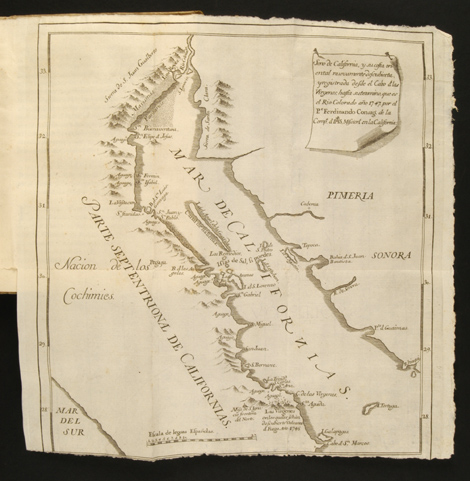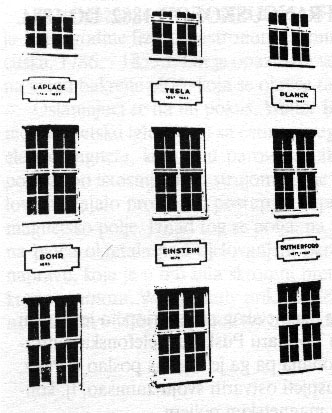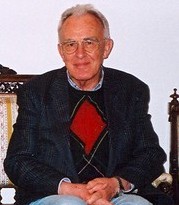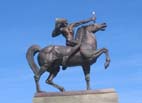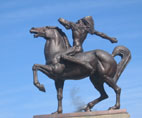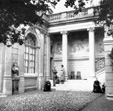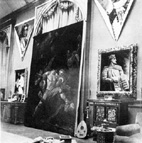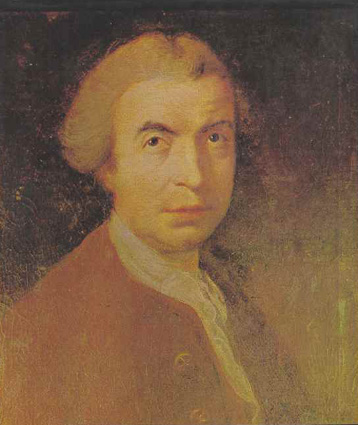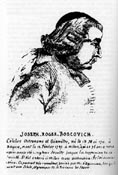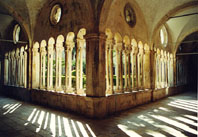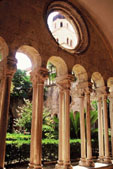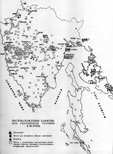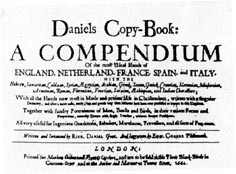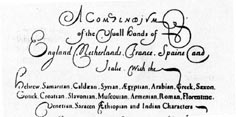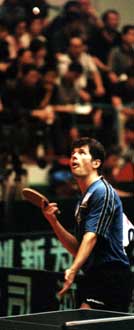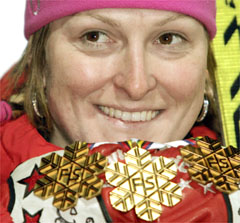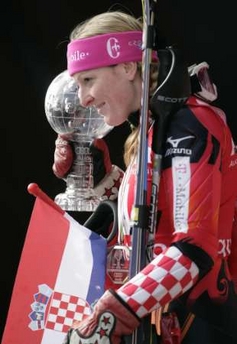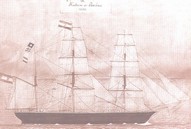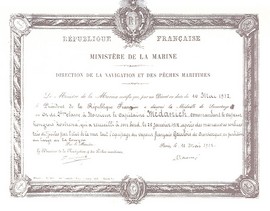Croatia - France
overview of historical and cultural relations - a sketch
Darko Zubrinic, 2006.Contents:
- General
- Science
- Art
- Dubrovnik
- Croatian Latinists, Humanists, and Encyclopaedists
- Croatian Glagolitic Script
- Music
- Zrinski's and Frankapan's
- Sports
- Croatian mariners
- Jelacic
- Cravate
- Liberté
Although Croatia developed under the impact of many different cultures - Greek, Roman, Celtic, Illyrian, Austrian, Hungarian, Byzantine, Islamic - it gave its own and unique imprint to the history of European civilization.
See Prehistoric Archaeology in Croatia.
Let us first give a very rough sketch of the main historical periods of the Croatia's past:
- the arrival of the Croats to the Balkan peninsula at the beginning of the 7th century,
- the period of Croatian Dukes and Kings of native birth (until 1102),
- Croatia sharing with Hungary a new state under common Hungarian and Croatian Kings (1102-1526),
- Croatia ruled by the Habsburgs, as a member of the Habsburg Crown (1527-1918, Austrian-Hungarian Empire from 1867 to 1918), parts of Croatia under Venice, Turkish Ottoman Empire and France,
- Croatia in the first Yugoslavia (1918-1941),
- The Independent State of Croatia (1941-1945),
- Croatia as a republic in Tito's (or second) Yugoslavia (1945-1991),
- internationally recognized Republic of Croatia (January 1992).
Croatia is a point of contact of very different cultures and civilizations. Across its territory or along its boundary
- the border between Western and Eastern Roman Empire had been laid by the Roman Emperor Theodosius in 395,
- the border between Francs and Byzantium (9th century),
- between Western and Eastern Christianity (11th century),
- and between Islam and Christianity (15-19th century).
Aucune
frontière en Europe n'est
plus lourde d'histoire que celle qui sépare Rome de Byzance,
l'Occident de l'Orient.
[Gregory
Peroche], p. 250.
The first known manual about book-keeping was "Della mercatura e del mercante perfetto," written by Benko Kotruljic (born in Dubrovnik, 15th century). Its French translation appeared under the title "Parfait négociant" in Lyon in 1613.
On the islet of Kosljun near largest Croatian island of Krk there is a beautiful Franciscan monastery, which had one of the oldest "banks" in Europe. It was operational from the 17th to 19th century, providing loans for the poor at low interest rates, to protect them from exploiters. See "What's on Kvarner," p. 81, available at Appleby.
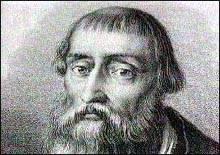 The
first technical
discoveries are related to the name of Faust
Vrancic (lat. Faustus
Verantius, italianized name Fausto
Veranzio, hungarized name Faustus
Verancsics, 1551-1617).
It is known that he collaborated with Tycho Brache and Johannes
Keppler. Vrancic was fluent in at least seven languages. At the court
of King Rudolph II in Hradcani in Prague (Rudloph II was Roman-German
Emperor and Croatian-Hungarian King) he worked as his secretary, and in
that period completed his important dictionary
of five most noble European languages
(Dictionarium quinque
nobilissimarum Europeae linguarum: Latinae, Italicae, Germanicae, Dalmaticae
et Hungaricae) and published in
Venice in 1595. He is best known
for his book of inventions in Machinae
Novae, published also in
Venice in 1595. The book was financially supported by the French King
Louis XIII, and the Toscan Duke Cosimo II de Medici. Among his numerous
inventions the most famous is the parachute,
which he tested in
Venice. It is true that Leonardo da Vinci had a similar idea earlier,
but he made only a rough sketch of it, of pyramidal shape, while
Vranic's parachute had rectangular shape, as today.
The
first technical
discoveries are related to the name of Faust
Vrancic (lat. Faustus
Verantius, italianized name Fausto
Veranzio, hungarized name Faustus
Verancsics, 1551-1617).
It is known that he collaborated with Tycho Brache and Johannes
Keppler. Vrancic was fluent in at least seven languages. At the court
of King Rudolph II in Hradcani in Prague (Rudloph II was Roman-German
Emperor and Croatian-Hungarian King) he worked as his secretary, and in
that period completed his important dictionary
of five most noble European languages
(Dictionarium quinque
nobilissimarum Europeae linguarum: Latinae, Italicae, Germanicae, Dalmaticae
et Hungaricae) and published in
Venice in 1595. He is best known
for his book of inventions in Machinae
Novae, published also in
Venice in 1595. The book was financially supported by the French King
Louis XIII, and the Toscan Duke Cosimo II de Medici. Among his numerous
inventions the most famous is the parachute,
which he tested in
Venice. It is true that Leonardo da Vinci had a similar idea earlier,
but he made only a rough sketch of it, of pyramidal shape, while
Vranic's parachute had rectangular shape, as today.
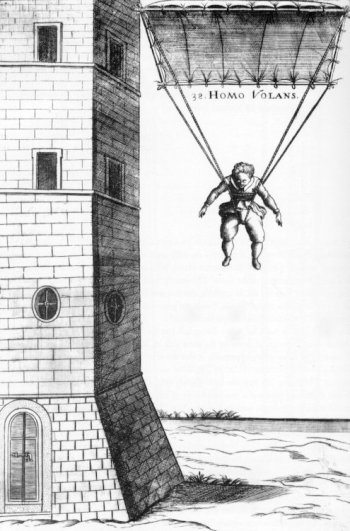

See Faust Vrancic (by dr. Vladimir Muljevic, in Croatian)
For example, the famous Verrazzano Narrows Bridge is the largest suspension bridge in the USA (New York, 1298 m), see also Historical Develpment of Iron and Steel in Bridges.
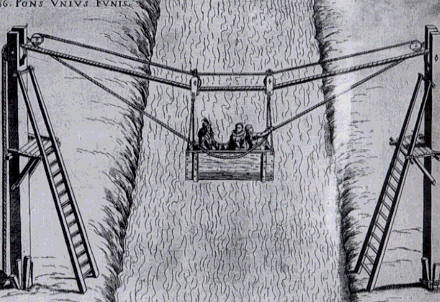
See Vladimir Muljevic: Hrvatski znanstvenici Antun i Faust Vrancic, Encyclopedia Moderna, god. 14, II, Zagreb, 1993. I express my sincere gratitude to Professor Emeritus V. Muljevic for this information.
Vrancic also described in his book Machinae Novae the first wind turbine:
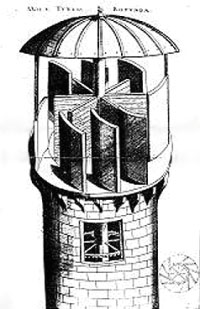
Marin Getaldic
- Ghetaldus (1568-1626) born in Dubrovnik,
was the most outstanding Croatian
scientist of his time. He studied in Italy, England and Belgium. His
best results are mainly in physics, especially optics, and mathematics.
Among his numerous books let us mention Promotus
Archimedus (Rome, 1603)
and De resolutione et
compositione mathematica (Rome,
1630), in
which
Getaldic appears as a pioneer of algebraization of geometry. His
contributions
to geometry had been cited by Christian
Huygens and Edmond
Halley. Getaldic is the
constructor of
the parabolic
mirror (diameter 2/3 m), kept today in the National Maritime Museum in
London.
During his sojourn in Padova he met Galileo
Galilei, with whom
he corresponded
regularly. He was a good friend to the French mathematician F.
Viéte.
The fact that the post of professor of mathematics had been offered to
him in
Louvain in Belgium, at that time one of the most famous university
centers in
Europe, proves his high scientific reputation.
A
Venetian Paolo Scarpi wrote about him: In
mathematics he was like a demon, and in his heart - like an angel.
According to a letter of an Italian scientist Buratini we know that the city of Dubrovnik possessed a telescope before Newton's discovery. It is very probable that it had been constructed by Getaldic. For additional information see here.
Quite a number of Croats took part in the first Christian Missions, especially in South and North America and Asia. Ferdinand Konscak, or Fernardo Consag (born in Varazdin, 1703-1757), was a Jesuit and a Croatian missionary in North America. In 1752 he discovered that Baja California was not an island, as it had been believed until then, but a peninsula. There is a collection of rocky islets on the north of the Californian bay named in his honour as the Consag Rocks (Consag Rocas, or Roca de Consag, near San Felipe).
Denis Diderot and D'Alambert used some of his maps for the French Encyclopedia, see "Encyclopedie", Supplement 5 Carte (Paris 1755-1780), where his name is cited as P. Consaque. Alexander Humbolt used his maps for his "Carte generale... de la Nouvelle Espagne", Paris, 1804, and also Arrowsmith in his "Map of America", London 1805. Konscak spoke various dialects of local Indians, in particular a very difficult dialect of Cochinin Indians. He described a sort of boomerang that Indians used for hunting rabbits. His diaries were printed already during his lifetime (published by Villa-Senor y Sanchez, Ortega-Balthasar and Venegas-Buriel), and after his death translated into many languages. The 1761 copy of Konscak's manuscript about California is held in The British Museum. His work Carta del P. Fernando Consag de la Compania de Jesus, Visistaro de las Misiones de Californias (43 pages) is kept in the British Museum in London, Library of Congress Harper in Washington, John Carter Library in Providence, Library of Pomona College in Pomona, Henry E. Huntington Library in San Marino. His life is described by outstanding american historian Peter Masten Dunne in his monograph Black Robes in Lower California, Los Angeles, 1952. Seven copies of his maps are published by Ernest J. Burrus in his work La obra cartografica, Madrid, 1967. In his 2000 monograph Zoric proved that Konscak was the author of important work Addiciones a las noticias contemidas en la Description compnediosa de lo descuviert y conocido de la California. Since Konscak discovered many springs of pouring water, it is not surprising that even today there exist shops and warehouses in California bearing his name: "Licores Konsag", Konsag Liquor Store and Mini Market", "Konsaqua" (agua purificada) etc. For many more details see [Zoric] and [Gabric].In his Addiciones... Konscak described the following amusing event with an (illiterate) Indian who had to carry a written message and a loaf of bread from one missionary to another. The Indian ate the bread on his road, and gave only the message to the missionary, without knowing that the message said among others that he had to bring bread as well. Being asked about the bread, the Indian said that he knew nothing about it. When the missionary told him that he ate it, he retorted "Who told you that?". The missionary answered "The paper that you brought told me that!" The next time the Indian was again asked to carry two loafs of bread and another written message. On his road he was passing by a huge rock, where he left the message, went with his loafs round the corner (so that the paper could not "see" him), and ate them. To his utmost amazement, the paper told the missionary not only that he ate the bread, but also how many loafs he ate. The Indian, having admitted that he indeed ate the bread, nevertheless claimed that it was impossible that the paper could see him eating the bread: "...I hid the paper so that it could not see me...The paper is the chatterer that speaks about things it did not see". Taken from [Zoric, pp. 177-178].
Simun Stratik (Simone Stratico, 1733-1829), outstanding specialist in nautical theory, was born in Zadar (in the family of Schiavoni which came to Zadar from Crete). He lectured mathematics and nautical theory in Padova, and then nautical theory at the University of Pavia. By the end of his life he prepared a new edition of Vitruvius' famous Architecture (1825) in four books accompanied with 320 tables. He published among others
- his translation into Italian (published in Padova in 1776) and his commentaries to the book of a famous Swiss mathematician Leonhard Euler Theorie complette de la construction et de la manoeuvre des vaisseaux (1733); Euler's text has 360 pp, and Stratik's commentaries 180 pp; the translation into Italian appeared before English and Russian translations;
- three language nautical dictionary Vocabolario di marina in tre lingue (Milano, 1813), Italian-French-English (in three books, the first book has more than 500 pp); the fourth book was also planned, but never issued.
Filip Vezdin or Wesdin (Paulinus a Sancto Bartolomaeo, 1748-1806), pioneer of European indology, was born in a Croatian village of Cimov (Hof am Leithagebirge) in Lower Austria in Burgenland (Gradisce). He completed his studies of philosophy and theology, Roman languages and English in Linz and Prague. Besides native Croatian he spoke Latin, Greek, Hebrew, German, Hungarian, Italian, Portuguese and English. As a Carmelitan missionary (with monastic name Paulin of St. Bartholomew) Vezdin was sent to India in 1776, where he learned Sanskrit and several Indian dialects.
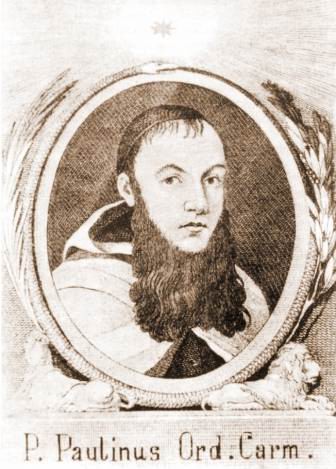
For more information see Filip Vezdin (in Croatian)
Vezdin is the author of Sidharubam seu gramatica samscrdamica, the first printed Sanskrit grammar in Europe, published in 1790 in Rome. Extended edition was published in 1804 and entitled Vyacarana seu locupletissima samsrdamicae linguae instituio.
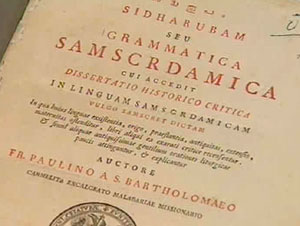
The first printed Sanskrit
grammar in Europe, written by Filip Vezdin in 1790,
photo from volksgruppen.orf.at/hrvati/visti/stories/45925/
He wrote numerous works on Indian culture, and in addition to Sanskrit also learned Malayalam, the Malabar coastal language, in which he wrote his works as well. At the request of a local ruler, King Rama Varmer of the Travancore, he wrote an English-Portugese-Malayalam grammar. The King, enthusiasted with Vezdin's fluency in Malayalam, asked him to be his teacher of English and Portuguese in his palace in Padmanabpuram. Vezdin's works are kept in Rome, Vienna and Uppsala. The first methodical study of connections between Indo-European languages is contained in his work De antiquitae et affimitate lingaue zendicae, samscrdamicae et germanicae disseratio, Rome 1798.
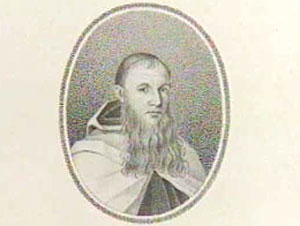
Filip Vezdin, pioneer of
European indology,
photo from volksgruppen.orf.at/hrvati/visti/stories/45925/
Vezdin's best known work is Systema brahmanicum liturgicum, mythologicum, civile ex monumentis Indicis Musei Borgian Velitris, Rome 1791, dealing with literature, mythology and civil order of brahmanic India, customs and the way of life. His most interesting and most popular work is his travel-book Viaggio alle Indie orientali, Rome 1796. He also published two philological studies about connections between Hungarian and Laponian languages. In 1999 Vezdin's image was carved into the white marble memorial plaque in the City Museum of Trivandrum, the capital of the Indian state of Kerala. He is considered as one of pioneers of European indology.
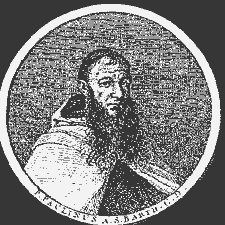
About twenty of his books were published already during his lifetime. Some of them were translated into German, French, English and Swedish. It is therefore no surprise that he was a member of the Royal Academy in Naples, and of the Academy "Dei Volsci" in Velletri and Padova.
Among scientists studying seismology the famous Moho-layer (or Moho-discontinuity) of the Earth is well known. It was named after the great Croatian geophysicist Andrija Mohorovicic (born in Volosko, 1857-1936), professor at the University of Zagreb. His discovery was essential for understanding the inner structure of the Earth and the behavior of seismic waves. Together with the theory of forces due to Rudjer Boskovic, this is probably the greatest achievement in the history of Croatian science.
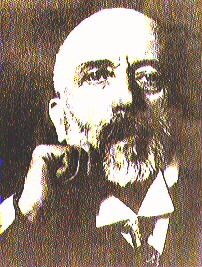
...As a boy of 15 he spoke Italian, French, and English as well as his native Croatian, later added German, Czech, Latin, and old Greek. He studied physics at the University of Prague under some famous professors including E. Mach and did his graduate work at the University of Zagreb, from which he obtained a Ph.D. In 1894 Dr. Mohorovicic became Director of the Institute for Meteorology and Geodynamics and Professor at the University of Zagreb in 1897, where he remained until his retirement in 1921. His special interest was the precise measurement of time for both astronomical and seismical events, but his reputation mainly rests on his classic paper in the field of seismology, The Earthquake of October 8, 1909, which contains the news of his discovery of a major discontinuity at a depth of 55 kilometers. This discontinuity, now generally known as the Moho in his honor, defines the crust of the earth. Professor Mohorovicic died in 1936 in circumstances approaching poverty.
Two Croatian names appear on the map of the Moon. The name of Rudjer Boskovic was given to a mountain on the visible side, and the name of A. Mohorovicic to a mountain on the dark side of the Moon.
Andrija Mohorovicic, links
Windows of the building of Electricité de Strasbourg in France, where Tesla had worked for some time, have inscriptions with names of outstanding scientists. There you can see his name surrounded with Laplace, Planck, Bohr, Einstein and Rutherford (click on the left). In front of the building of International Union for Telecommunications in Geneva there is a statue of Nikola Tesla. When his mother died, he payed a visit to Croatian capital Zagreb in 1892, where he gave a lecture about alternating current. On that occasion he said:
As a son of my homeland I feel it is my duty to help the city of Zagreb in every respect with my advice and work (Smatram svojom duznoscu da kao rodjeni sin svoje zemlje pomognem gradu Zagrebu u svakom pogledu savjetom i cinom; photo)
Zvonimir Janko, professor of mathematics at the University of Heidelberg, is a well known name among experts in the theory of finite groups. He discovered sporadic groups named J1 (discovered in 1965, more than century after the first sporadic group), J2, J3, and J4 in his honour (there are altogether 26 sporadic groups). The discovery of J1 launched the modern theory of sporadic groups. About his research he delivered one among four plenary lectures at the International Congress of Mathematicians in Nice, France, 1970.
- A.A. Ivanov (professor at Imperial College, London): The Fourth Janko Group (256 pp), Oxford Math. Monographs, 2005.
- Janko Groups at Wolfram MathWorld
- Janko Groups at Wikipedia
Agabekov SA is world's famous company seated in Geneva, Switzerland, dealing with exterior lighting design. Mr Youri Agabekov, the founder of the company, has Croatian roots: his father is Ladislav Zerjavic, from Hrvatsko Zagorje near Zagreb. His products have been used to cover with soft lighting such buildings like (photos by kind permission of Mr. Youri Agabekov):
- the Vatican
- Louvre, Paris
- Bolshoi Theatre, Moscow
- Saint Michel Bridge, Paris
- Palace of Sponza in Dubrovnik, Croatia
- Villa Astra in Lovran, Croatia
- Guernica by P. Picasso, Paris
- College de France, Paris
- Kingston Bridge, London
- Siltassari and Pitkäslita Bridges in Helsinki (Finland)
- Museum Arqueologic de Catalunya and Cathedral of Barcelona
- Cathedral of Palma de Mallorca, Spain
- Queen's Residence "Parlement" in Holland
- Princely Palace of Monaco
- National Museum Singapore
- Palacio National Mexico
- Banque Européenne in Bruxelles (Belgium)
- National Bank of Greece in Athens
- Bank of Luxemburg, etc.
Mr Youri Agabekov is a Croat born in Russia, living in Switzerland (Geneva) and in Croatia (Zagreb). His company, Agabekov SA, has 80 representatives throughout the world. Here is the logo of the company devoted to his wife Branka:
Miroslav Radman élu à l'Académie des Sciences, France, 2002 (Biologie cellulaire et moléculaire)
Emilio Marin, associé étranger de l'Académie des Inscriptions et Belles-Lettres, 2003 (archéologie et histoire)
The service of buying parking tickets via mobile phones is today widespread worldwide. The service has been conceived and developed in Croatia.
Gjuro Baglivi (born in Dubrovnik, 1668-1707) was a professor of anatomy and theoretical medicine in Rome (Sapienza) already at the age of 28, and the Pope's physician. He developed a theory that living fibre was the anatomical and physiological element of all pathological processes (fibral pathology). He also had some essential discoveries in the fine structure of muscles. His collected works written in the Latin language had more than 20 editions, translated into Italian, French, German and English. Académie Française accepted him as "membre d'honneur". Baglivi was also a member of the Royal Society in London.
His Ragusan colleague Anselme Banduri (1675-1743) became a famous antique numismatist in Paris, and entered Académie des Inscriptions et Médailles.
Gjuro Dubrovcanin (Gjuro de Ragusa, that is, Gjuro from Dubrovnik) published his "Epistolae Mathematicae" in Paris in 1680.
Rugjer Boskovic, Dubrovnik
Count Edgar Bourée de Corberon (1807-1861) was descendant of an old French noble family (born in Troissereux, dpt. of Oise), polyglot and interesting Croatian intellectual. In 1845 he arrived to Zagreb, and settled in Janusevac near Brdovec, the most beautiful Croatian palace at that time. He was a good friend to Ban (viceroy) Josip Jelacic. In his letters Corberon wrote about Croatia as his second homeland, about dangers of intensive magyarization (in his letters to the Hannover king Ernest August I written in French) in turbulent years around 1848.
His generous material support of various Croatian institutions persuaded him to leave the palace of Janusevac, and to settle in Bisag, in Draskovic's palace near Komin. In 1851/52 he urged Ban Josip Jelacic to reestablish the University of Zagreb to full extent (in 1850 the Faculty of Philosophy was concealed), offering his help as a potential lecturer. As a witness of epidemic of typhus and cholera in Croatia in 1851 he asked the Austrian monarchy officials to open the Faculty of medicine in Zagreb, suggesting its precise structure. Unfortunately, the faculty of medicine was opened only in 1917., during the reign of Emperor Franz Joseph I.
By the end of his life
Corberon wrote his Programm
für die Erweiterung der Königlichen Akademie Agram
[Zagreb]
to einer volständigen Universität,
but the sudden illness
and death prevented him from completion of his work. According to his
last will, he was buried in Croatia in Bisag. How much he loved his new
homeland can be seen from the fact that (also according to his last
will) even obituary notices in his native Troisseraux in France had to
be printed in Croatian.
See Alojz Getliher, Marulic
3, Zagreb, 1999, pp 528-537.
Mirko Drazen Grmek (1924-2000), born in Krapina near Zagreb, was professor of history of medicine at the University of Zagreb, where he founded Institute for History of Science, and directed the first Croatian Medical Encyclopedia. Since 1971 he has been full professor at the Sorbonne in Paris, then associate professor of many European and American universities (Berkeley, Cambridge-Masachusetts, Geneva, Lausanne, Bologna, Rome, Zagreb), and finally Director of Studies at the École Practique des Hautes Études, Sorbonne, Paris.
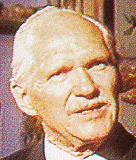
- Very important is Western medical thought from antiquity to the Middle Ages, a landmark work edited by Mirko D. Grmek.
- His monograph History of AIDS: Emergence and Origin of a Modern Pandemic, is winner of the George Sarton Medal of the History of Science Society.
- With Louise Lambrichs he wrote a monograph Les révoltés de Villefranche-de-Rouergue,
- and with Marc Gjidara and Neven Simac Le Nettoyage ethnique,
- Docteur Grmek - Ecrits autobiographiques et politiques de l'historien de la médecine,
- Mirko Grmek: La mémoire manipulée (Le Monde, 12/04/1991), Mirko Grmek est directeur d'études a l'École pratique des hautes études
In 1996 the international scientific journal Eureka called him physician of the century. The journal portrayed him with the following words:
Mirko Grmek is as famous among scholars throughout the world as he was unknown to the wider public. This Croat lived supporting the ideals to which he dedicated his entire life, namely that medicine must be practiced with full sense of conscience, and that science is simply another word if it is not accompanied by humanism.His particularly important books are
- Les maladies a l'aube de la civilisation occidentale, Payot, Paris 1983 (Deseases in the Ancient Greek World, John Hopkins Unversity Press, 1989)
- Histoire du sida, Payot, 1989 (History of AIDS, Princeton University Press, Princeton 1990; the first such book)
- (editor) Histoire da la pensée médicale en Occident, I, II, III, Seuil, 1995-1999 (Western medical thought from Antiquity to the Middle Ages Cambridge, MA, 1998)
- Le Legs de Claude Bernard, Fayard, 1997
- La vita, la malattia e la storia, Di Renzo Ed., Rome 1998 (French translation La Vie, les maladies et l'histoire, 1999).
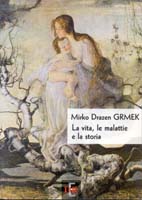
![]()
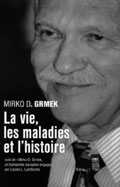
La troisième révolution scientifique
In memoriam to professor Grmek
The SUVAG center for voice transmission for reeducation of speech disorders and deafness has been founded in Zagreb in 1961 by Academician Petar Guberina (1913-2005). The name of SUVAG is coined from Systeme Universel Verbotonal d'Audition Guberina.
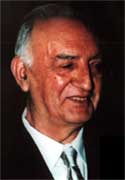
- Knighthood in 1968,
- the Officer’s Cross in 1989, which he was awarded in main quadrangle of the Sorbonne in Paris.
Jacques
Le Goff:
...the flowering of one of the
finest European artistic traditions
of the Early Middle Ages...
From his foreword to "Croatia
in the Middle Ages:
A Cultural Survey"
Frano Laurana, known also as Francesco Laureano (1420 - 1502), a Croat born near Zadar, was a sculptor in Italy (Naples, Messina, Palermo) and in France (Aix, Marseille, Avignon, Le Mans, Tarascon). In France (Provence) he worked at the Court of Bon Roi René, and married a daughter of a French painter in Avignon. His portrait busts of women represent the highest achievement of the Quatroccento sculpture. They can be seen in galleries in Palermo, Vienna, New York and Paris (Louvre, Musée Jacquemart - André). His disciple was the famous Donato Bramante. See [Gregory Peroche], p. 72.
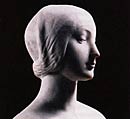
Here we mention a French artist Charles François Beautemps-Beaupré, who prepared a superb collection of drawings of Croatian coast in his atlas entitled Reconnoissance hydrographique des ports du Royaume d´Italie situés sur les côtes du Golphe de Venise commencé en 1806 par ordre de sa majesté Napoleon. 1806. It contains 15 hand-drawn maps of various sizes, 2 sheets of coastal contours, water colour drawing. This unique Atlas, kept in the National and University Library in Zagreb, is according to presentation given by the British Library (follow the above link) of outstanding artistic and scientific value, and is a contribution to the scientific, cultural and historical accounts of the Croatian coast.
In the Musée du Louvre in Paris (l'aile Déon) dedicated to Italian sculpture of Quattrocento, two Croatian artists are represented, Francesko Laurana and Giovanni Dalmata de Trau (Ivan Duknovic from Trogir). Their 4 sculptures and bas-reliefs can be seen in the first hall. It is interesting that Renaissance art appeared in Croatia about a hundred years earlier than in France. See information about the exhibition La Renaissance en Croatie at Musée national de la Renaissance in Paris in 2004.
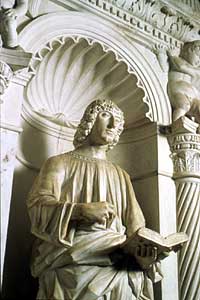
In the fine arts of our time probably the most famous is the sculptor Ivan Mestrovic (1883-1962), who created masterpieces, many of which are dedicated to the history of his motherland. You can see them in the Mestrovic gallery in Split and in Croatian capital Zagreb. He also created
- the bust of Cardinal Alojzije Stepinac, New York (Croatia Place, Lackawanna),
- the grand ``Monument of the Unknown Soldier'' and ``The Monument of Gratitude to France'' in Belgrade,
- the beautiful Mausoleum of Petar Petrovic Njegos, Montenegrin poet and statesman (Lovcen in Montenegro),
- ``The Well of Life'' in Zagreb,
- ``History of the Croats'' (symbol of the University of Split), whose several copies are held in Croatia, while the original is in Belgrade (!), capital of the new Yugoslavia. He planned it to be situated in the "Museum of Croatian Antiquities" in Split. One expects the Serbs to return this important monument to Croatia.
 His
sculptures can be seen in London (Tate Gallery), Florence (in
"Uffizi"), Torino, Rome, Prague (in Hradcany), Budapest, Chicago (Chicago
Indians, Grand Central Park, see
a postcard on the right from 1939
and two photos below), South Bend (Indiana, USA), Rochester (Minnesota,
USA), Baton Rouge (Louisiana, USA) etc. He also carved a monument of
the most outstanding Slovak writer Martin
Kukucin (Matej
Bencur) in Punta Arens (Patagonia, Argentina). Matej Bencur spent a
part of his life in Croatia on the island of Brac and wrote a book
about the life of the Croatian emigrants in South America.
His
sculptures can be seen in London (Tate Gallery), Florence (in
"Uffizi"), Torino, Rome, Prague (in Hradcany), Budapest, Chicago (Chicago
Indians, Grand Central Park, see
a postcard on the right from 1939
and two photos below), South Bend (Indiana, USA), Rochester (Minnesota,
USA), Baton Rouge (Louisiana, USA) etc. He also carved a monument of
the most outstanding Slovak writer Martin
Kukucin (Matej
Bencur) in Punta Arens (Patagonia, Argentina). Matej Bencur spent a
part of his life in Croatia on the island of Brac and wrote a book
about the life of the Croatian emigrants in South America.
Mestrovic's 1939 sculpture representing Croatian ban and bishop Petar Berislavic (killed by the Turks in 1520) was exhibited on the central square of the city of Trogir. During the Italian Fascist rule the sculpture was destroyed. In 1970 a replica has been installed on the same place. Petar Berislavic was a close friend to a famous Croatian writer Marko Marulic, who described his tragic death.
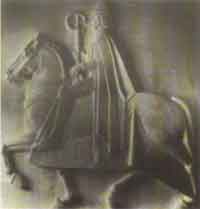
The grave of Mestrovic was desecrated by the Serbs in his birthplace Otavice during the 1991-1995 occupation of the Krajina region. Some of the original pieces of art from the Mestrovic Mausoleum were damaged, and some were stolen and transported to Belgrade. The remains of "The Monument of Gratitude to Motherland" can be seen in the beautiful Visovac Monastery on the river Krka.
Mestrovic was a student of August Rodin.
Ivan Mestrovic: ON RELIGIOUS ART (1954), excerpt: "...The head of that suffering Church is Cardinal Stepinac, my compatriot, my dear friend, of whom I and all Croats are proud. I am sure that our feelings are shared not only by all the Catholics throughout the world but also by all men of goodwill everywhere who cherish freedom of spirit..."
Please, do not miss the following deep thoughts of Ivan Mestrovic, as if written today (taken from Zeljko Skropanic web site, see the complete text):
There are more and more people today who have come to the conviction that one of the main causes of the tragic events of the recent past, as well as those which loom on the horizon, is the fact that modern man has all but forgotten the great teachings of the Sermon on the Mount [The Bible, Mathew 5-7]. The blame for this rests not only on our contemporary despotism, but, unfortunately, on a long list of talented men of science and art who have not foreseen the corroding complications and destructive consequences of their doctrines. This atmosphere of unbelief, this tragic state of man cut off from the very axis which holds and moves everything, has had repercussions on all domains of human activity, including that of art, which in the most significant periods of civilization worked hand in hand with religion - an ennobling and spiritualizing factor in human life.
Christian civilization, in our days, finds itself locked in a mortal struggle with the forces of secularism in varying forms and degrees. Many people fail to realize that Christianity, by waging the fight for its principles, defends also the foundation of the democratic way of life; for the concept of the dignity of each man and the equality of all men stands and falls with the Christian view that man is created in the image of God. Thus the Church is in the front lines of the battle against the onslaughts on human freedom.
A moment ago, I mentioned my wood carving of the scene of the Crucifixion. The piece of wood on which I carved the Crucifixion has an interesting story which I would like to share with you. I was in Geneva, Switzerland, when I was seized by the desire to carve the Crucifixion. Every available oak had been bought by the factory that manufactured rifle buts, presumably for both warring sides. I had a hard time to acquire from the factory a few boards for relief. I was unable to get the whole piece of the trunk because they had all been sawed up. Finally, I discovered one trunk that had not been sawed off; it was withered and had stood with its roots in the soil and was not considered good for rifles because it was assumed that the wood was probably decayed. When I started to work on it, I discovered that it was solid and whole. The lumberman told me that it had been imported. I was surprised to learn that it had come from Croatia, my native country.
That same piece of wood was later returned to Croatia, transformed into the Crucifixion scene. Today it stands there, in a small Chapel, in the country where the Catholic Church is being crucified daily. The head of that suffering Church is Cardinal Stepinac, my compatriot, my dear friend, of whom I and all Croats are proud. I am sure that our feelings are shared not only by all the Catholics throughout the world but also by all men of goodwill everywhere who cherish freedom of spirit
In vain do the Godless and restless men, who are today making weapons in the hope of enslaving the world, think that the trunk of the Christian tree is withered. It will outlive and outlast the forces of evil in my native land and throughout the whole world. He who has conquered death will conquer the destruction of His teaching.
One of Mestrovic's major works is Moses, the monument donated to the people of Israel.
In 1928 Mestrovic sent four recommendation letters to his influential friends in Croatia in which he asked to help the Croatian Youth Society BUNJEVAC from the city of Subotica to visit the land of their grandparents - Dalmatia and Herzegovina. As he stated, Bunjevci Croats in Baccka have preserved the character of their grandparents in their ikavian speech and customs. See "Marulic", 5/1998, 908-911.
In 1954 Mestrovic became a citizen of the United States at a ceremony conducted by President Eisenhower at the White House. See his daughter's article.
Croatian painter and muralist Maximilian (Maxo) Vanka (Zagreb 1889 - Mexico 1963) finished his studies at the Academy of Fine Arts in Zagreb, where later he became professor of painting. He also studied at the Brussels Academy of Fine Arts, Brussels, Belgium. As a young student he exhibited at an international show in the Belgian capital and in 1914 won the gold medal of King Albert at this event, for his Bistricki prostenjari (Marija Bistrica fairgoers) with beautiful Croatian folklore motives. He made a nice portrait of Croatian female composer Dora Pejacevic (1885-1923):
Vanka exhibited throughout Europe, and obtained many honours, among them Palme Academique of the French Legion of Honor. Having moved to the USA in 1934, he became noted for his beautiful church murals, for example in St. Nicholas Croatian Church, Pennsylvania. Some american specialists consider these murals the best church frescos in the USA. He depicts not only traditional Catholic scenes and symbols, but also the lives and spirituality of the Croatian immigrant community.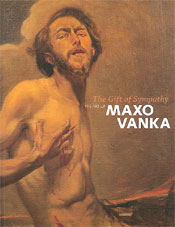
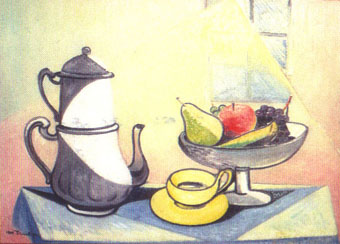
|
I
painted so that Divinity in
becoming human,
would make humanity divine. |
His main interests were in folklore and social motives, human destiny in general. One of his deeply moving masterpieces is Lepers, a result of his short stay in India.
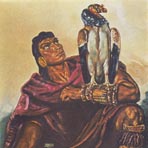 Kristian
Krekovic (1901-1985),
outstanding Croatian artist, born in the village of Koprivna near Tuzla
in Bosnia
- Herzegovina, in the family of
forester from Croatian region of Lika,
died in
Palma de Mallorca. He studied in Vienna and Paris, and already since
1928 was a member of the French Society of Visual Arts. The same year
he was awarded the gold medal in Bordeaux (Exhibition of international
art). Krekovic portrayed many ministers, statesmen, and outstanding
persons like
Kristian
Krekovic (1901-1985),
outstanding Croatian artist, born in the village of Koprivna near Tuzla
in Bosnia
- Herzegovina, in the family of
forester from Croatian region of Lika,
died in
Palma de Mallorca. He studied in Vienna and Paris, and already since
1928 was a member of the French Society of Visual Arts. The same year
he was awarded the gold medal in Bordeaux (Exhibition of international
art). Krekovic portrayed many ministers, statesmen, and outstanding
persons like
- Mahatma Gandhi (1931, in his atelier in Paris),
- the English Queen (in 1938, upon her request; the portrait is kept in the Buckingham palace in London, see [Sabater, p. 19]: "...Como expresión de su trabajo en esta época, basta citar el famosos retrato que hizo de la Reina María de Inglaterra, retrato que adorna una de las estancias del Palacio Real de Buckingham.",
- the royal family of Spain (King Juan Carlos and Queen Sophia), and
- the royal family of Sweden (King Gustav V upon his invitation to Stockholm in 1948, when he was at the age of 90),
- Queen Mary of Romania.
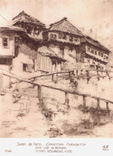 On
the basis of his works of
art a seris of postcards has been issued by the City of Paris, among
others with the following motives:
On
the basis of his works of
art a seris of postcards has been issued by the City of Paris, among
others with the following motives:
- Old Bosnian houses, (1925)
- A street in Dubrovnik,
- A she shepherd from Bosnia (the picture was exhibited in the luxorious club of Pasia in Paris, and represents a Croatian girsl in national costume, with sheep; today it is probably in the Art Gallery of BiH in Sarajevo).
Kristian Krekovic with his wife Sina in front of their atelier in Paris, 1934.
The inside of Krekovic's atelier in Paris
When Mahatma Gandhi traveled from India to London, he would stay in Paris in order to visit his friend Krekovic, see [Möller Rizo, str. 27].
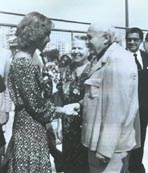 His
extensive opus
of 143 large format works, devoted to Croatian history, including 63
portraits of Croatian
Dukes and Kings
(from Porga from 620 till Stjepan Tomasevic in 1463), was unfortunately
not preserved. Between 1928 and 1966 he visited Peru many times, so
that his work became deeply imprinted by the life and art of Incas.
Since 1955 he lived in Peru, and accepted Peruvian citizenship offered
to him. He had great success with exhibitions of
His
extensive opus
of 143 large format works, devoted to Croatian history, including 63
portraits of Croatian
Dukes and Kings
(from Porga from 620 till Stjepan Tomasevic in 1463), was unfortunately
not preserved. Between 1928 and 1966 he visited Peru many times, so
that his work became deeply imprinted by the life and art of Incas.
Since 1955 he lived in Peru, and accepted Peruvian citizenship offered
to him. He had great success with exhibitions of
(that is, Present and past of the fabulous Peru) in
- New York (Law Memorial Library Columbia University; Ambassador Hotel, 1956),
- Washington D.C. (National Museum of the Smithsonian Institution, 126,000 visitors in July and August 1955, that is, more than 2,000 people daily!); see an excerpt from the article by Thomas Beggs, director of the Fine Art Collection of the Smithsonian Institution, published in "The American Artist",
- Siracuse (The Siracuse Museum of Fine Arts, 1956)
- Boston,
- Philadelphia (University Museum, 1955),
- Madrid (Circulo de Bellas Artes, 1957),
- Lima (exhibition opened by the president of Peru, Manuel A. Odria, 1954),
- Vienna (Neue Hofburg, former Royal palace, the exhbition was visited also by Dr. Schaerf, president of Austria, 1957),
- Barcelona (Galeria Grifé & Escoda, under the patronage of the president of Peru, Ayutamient de Barcelona, and presented by the Instiut of Hispanic Studies, 1957),
- Palma de Mallorca (Casa de Cultura, 1961), etc.
In the course of Krekovic's first exhibition in the USA (held in New York) he was described as "Yugoslav painter". Krekovic did not permit such misrepresentation, and warned the organizers that he would not allow the exhibition to go on if he were not described as Croatian-peruvian painter. He succeeded, despite the protests from the embassy of ex-Yugoslavia.
It is not surprising that he is often described as Croatian born Peruvian artist, or as Poeta de la pintura. Krekovic signed himself as pintor croata or pintor croata-peruano. His grand exhibition of ethnographic paintings held in 1954 in Lima, was opened by the president of the state.
In 1966 the famous Peruvian city of Cuzco (or Cusco), the old capital of The Inca Empire and "The archaeological capital of South America", conceded him honorary citizenship and the Gold medal of the city.
Since 1965 he settled in Palma de Mallorca, where in 1977 he built the Museum of Palma de Mallorca with his works of art, now known as Museu Krekovic (Collección Pintor Krekovic). The Krekovic Museum was officially opened in 1981 by the Spanish Queen Sophia. In the guestbook she wrote:
The following fascinating work is entitled Exodus of the 20th century. Note that all races are represented, with a couple in Croatian national costumes on the right (in fact his auto portrait and portrait of his wife Sina). Also, the far right person represents a Jew with a typical Jewish cap.
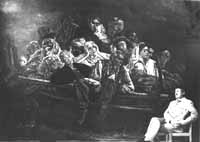 |
Mahatma Gandhi, who was a personal friend of Kristian Krekovic (see [Gaspar Sabater, pp. 38 and 54]), wrote the following:
El sentimiento de Kristian Krekovic hacia el mundo es único. Impregna todo su arte e impregna con extraordinario creatividad y constructivo carácter.
Manuel Vegas Castillo, Director of Culture of the Peruvian Ministry of Education:
Kristian Krekoviæ, the Croatian-born artist, has dedicated his life and his Art to the fabulous Empire of Incas, Pre-Incas and present day Hispano-American Folklore, with such prodigality of love and truth, art and knowledge, force and sensuality, sacrifice and perseverance, the likes of which have never been equaled by any other painter in the artistic history of America.Over the long years when I had the honor of directing and guiding the culture of my country, I have been able to observe the superhuman efforts made by Krekoviæ who visited museums all over the world to study the New World archaic cultures and to paint in their collections the precious textiles, pre-Columbian jewels and adornments for his paintings. I was also an exceptional witness to his expeditions in the native regions of the Andes to heights around 10.000-12.000 feet [3-4.000 meters], in order to seek out and paint the purest and most representative types of the Aboriginal race, there on the spot.
The splendid Krekovic collections enjoys its great prestige because it is the only in the world which presents the Art and Culture of the South American Indian that legendary bronze race of the Incas, with such astonishing and brilliant results, excellence in picturing, strongest historical and scientific authenticity, creative imagination and magnificent interpretation. The whole undertaken and realized by one single man. This explains the enormous success, endorsed by the critics, which his exhibitions have enjoyed in the most important cultural centres of Europe and U.S.A.
Krekovic's paintings are such expressive compositions, and almost three dimensional. His brush-strokes are definitive, his colouring luminous. He cannot be classed among any existing Schools, he is quite unique and apart. His Peruvian work has no equivalent, and occupies a special place, not only in the artistic history of Peru, but in the Art of all time. Nobody can visit his collection without being profoundly impressed by it.
For his artistic merits the Peruvian Government has granted Mr. Krekovic the "Order of Merit for distinguished Services" and furthermore the President of the Republic of Peru has patronised his exhibitions all over world, a most exceptional distinction.
BARCELONA; "La Vnaguardia Espanola": Juan Coretés, 1957.
"...as sensational, without any exaggeration, can be qualified the exhibition brought to us by the Croatian-born Peruvian artist Kristian Krekovic. His, for the most part monumental paintings are masterly and complicated composition, with absolutely perfect drawing, masterly treatment of chiaroscuro and brilliant and luminous palette...".
The above two texts are taken from the prospect Krekovic Collection, Palma de Mallorca (many thanks to Mr. Vladimir Novak for this and related materials).
Es
uno de los más grandes pintores de
todos los tiempos.
Camille Mauclair, see [Gaspar Sabater,
p. 45-46]
Krekovic used Croatian Glagolitic script in daily correspondence with his friend Marko Dosen (president of Croatian Parliament during the WWII period), as was the custom also in his family during his childhood. His wife was Sina, a Frenchwoman who mastered Croatian language perfectly, using many Croatian expressions and words already expelled during the Yugoslav period. Born in Paris in 1910, daughter of outstanding surgeon, she spoke also Quechua, Catalonian, Spanish, Italian, German (studied piano at the Vienna Conservatory), French, Russian, and English. Krekovic dreamed about free Croatia, and to start again working on his Croatian cycle, but he died too early. It is worth mentioning that in 2002 Javier Bizarro Bentitz won the prestigious "Premio de Poesia Antonio Machado" with his poem Los fantasmas del Parque Kristian Krekovic, among 154 other works.
Many thanks to Mrs Ingeborg Möller Rizo (UN, New York) for sending me a copy of her Mémoire de Maîtrise in 2006, entitled "Krisitan Krekovic", written in French in 1974 (Cours Universitaire Cluny). Many thanks also to Nenad Bach for bringing the copy from New York to Zagreb.
Here is an excerpt from the Introduction to the 1974 Master thesis of Ingeborg Möller Rizo:
Comme sujet pour le mémoire de maîtrise j'ai choisi le peintre croate-péruiven Kristian Krekoviæ. Mais ce n'est pas seulement sur sa peinture qu je vais écrire. Je veux parler de se vie, de ses idées, que je trouve extrêmement intéressantes.
...La premièr fois que j'ai visité son musée, ses peintures m'ont ému; cette émtion se repète chaque fois qu j'y vais. Je trouve ses toiles tellement belles!
Mais ce que j'aime dans sa peinture n'est pas seulement la forme avec son immense gamme de couleurs. C'est également le fond....Une raison importante pour laquell j'ai choisi d'écrire sur Krekoviæ, son ses idees sur la paix et sur la tolérance et le respet mutuel entre les êtres humains.
Avec mon memoire je voudrai faire connaiîre Krisitan Krekoviæ et mener les personnes qui liront mon travail à visiter la Collection Krekovic si un jour elles vont à Majorque. Je voudrais aussi faire hommage à ce peintre que j'admire...
Ante Dabro, born in Croatia in 1938, began carving as a shepherd. His talent was first noticed during his childhood, when he carved a dove so precisely, that his cat jumped on it. He studied under Antun Augustincic in Zagreb. Not agreeing with communist Yugoslavia, since 1967 he lives in Australia, where he became one of the most outstanding sculptors. He exhibited in many european cities, and his work is especially esteemed in London. Some of his most important works include Royal Australian Navy Memorial (see also here and here; opened by Queen Elisabeth II in 1986, placed near the Australian Parliament in Canberra), La Perouse memorial in Paris (built in honour of an 18th century French explorer and naval officer Jean-François de Galoup, Comte de La Pérouse; ordered by the French Ministry of foreign affairs, placed about 200 meters from the Eifel tower). In 1999 the ANU (Australian National University in Canberra) Drill Hall Gallery held a major survey exhibition of his work, celebrating 30 years of his activity in Australia. In his short biography presented at the School of Arts of the Australian National University, where he lectures, we can read the following: While he supports contemporary changes in art, Ante remains a passionate guardian of traditional artistic conventions.
Vrigilije Nevjestic is one of today's greatest graphic artists, a professor in Paris (since 1977 at the ``Institute for the formation of restorers of works of art'', and also the chief of the ``Atelier for artistic technology''). His masterpieces are in possession o many private collections, including a collection of Georges Pompidou, a former president of France. One of his famous large-scale paintings is Vukovar, which he described as a scream, revolt against an evil done to the Croatian people.
A good illustration of the intensity of the cultural life in Croatia in the 19th century is the following: just in the period from 1868 to 1883 the Croatian Theater in Zagreb had as many as 140 (hundred and forty!) premières of the pieces written by French authors, with approximately the same pace until the end of the century. Similarly in Dubrovnik, Zadar and Split, see [Croatie/France], p. 233.
The grand Croatian National Theater in Zagreb was opened in 1895. The Croatian National Theater ``Ivan pl. Zajc'' in Rijeka is still older - built in 1885.
Sarah
Bernardt visited Zagreb twice,
in 1889 and in
1904, with La Tosca
and La dame aux
camélias,
performed of course in French. Also according to [Dolbeau]
she had several visits to Zagreb. Is it true that Émil
Zola
had Croatian roots, as claimed by the French intellectual Cristophe
Dolbeau, see p 47 (Colich -> Zola)? The French writer George
Sand
wrote her novel "Uscoque" (Uskok) in 1838, Prosper Merimée
wrote
his famous "Guzla" in 1827, both obviously inspired by Dalmatia and its
inhabitants. The French writers were extremely popular in Croatia in
the 19th century.
French
universities allocated about 600
scholarships to ex-YU students each year between the two WWs. Here the
Croatian students were represented with only by 5, i.e. with less than
1% (one percent). Despite this, in the same period more than 100 French
authors were translated into Croatian by Zabavna biblioteka led by
Nikola Andric in Zagreb. See [Gregory Peroche],
p. 210.
 ...Une
des toutes
dernieres productions originales de Croatia Film, "Lapitch - Le petit
cordonnier", tiré d'un conte de Ivana Brlic Mazuranic, femme
écrivain croate du XIXe siecle, est actuellement le produit
phare de l'école : avec plus de 300 000 cassettes
vidéos
vendues rien qu'en France, commercialisées par TF1
Vidéo,
il représente la production audiovisuelle croate la plus
recherchée sur marché international. (source: Ambassade de Croatie en France).
...Une
des toutes
dernieres productions originales de Croatia Film, "Lapitch - Le petit
cordonnier", tiré d'un conte de Ivana Brlic Mazuranic, femme
écrivain croate du XIXe siecle, est actuellement le produit
phare de l'école : avec plus de 300 000 cassettes
vidéos
vendues rien qu'en France, commercialisées par TF1
Vidéo,
il représente la production audiovisuelle croate la plus
recherchée sur marché international. (source: Ambassade de Croatie en France).
Croatia and Europe, in five monumental volumes. See Jacques Le Goff's foreword to its second volume (French edition).
Ivan Mane Jarnovic (1740-1804) was an outstanding Croatian violinist and composer of the 18th century, probably from Dubrovnik. He had a true European career - playing, composing and conducting in France (Paris), Austria, Germany, Switzerland, Poland, Scandinavian countries, England. Also played the first violin in the orchestra of the Russian empress Katarina II. Jarnovic composed about 50 chamber instrumental pieces, 22 violin concerts (17 preserved), and is known for having introduced the romanza as a slow movement into the structure of the violin concert. His life is described in a novel Jarnowick by G. Desnoisterres - Le Brisoys, Paris 1844, and in a collection Scènes de la vie d'artiste by P. Smith (Une leçon de Jarnovic, Paris, 1844).
Let us mention the name of Dobric Dobricevic (Boninus de Boninis de Ragusia), Ragusan born on the island of Lastovo, 1454-1528, who worked as a typographer in Venice, Verona, Brescia. His last years he spent as the dean of the Cathedral church in Treviso. His bilingual (Latin - Italian) editions of "Aesopus moralisatus, Dante's "Cantica" and "Commedia del Divino" were printed first in Brescia in 1487, and then also in Lyon, France. We know of about 50 of his editions, the greatest number belonging to the period of 1483-1491 that he spent in Brescia - about 40. Croatia is in possession of 19 of his editions in 30 copies. The greatest number of his editions is in possession of the British Museum, London (22)
The greatest and most famous Croatian philosopher and scientist Rudjer Boskovic (Boscovich, 1711-1787), was born in Dubrovnik, where he was educated in the Jesuit Collegium. He was a member of the Royal Society of London, a member of St.Petersbug Academy, "membre correspondant" of the French Academie Royale des Sciences, a member of the Accademia dell'Arcadia, a professor at many European universities. Very delicate work on repairing the cupola of St. Peter's church in the Vatican (diameter: 42m) was entrusted to R. Boskovic, a proof that he was a leading European authority for static computations and civil engineering of that time. Upon the request of Austrian Empress Maria Theresia, Boskovic was solving the problem of stability of Royal Library (now National Library) in Vienna.
Portrait of Boskovic by the English painter Edge Pine (London, 1760).
He was also the founder of the astronomical observatory in Brera near Milan. In 1773 a charter granted by Louis XV made him a French subject. Soon he was appointed by Louis XV to a very prestigious position and became the Director of Naval Optics of the French Navy in Paris (Optique Militaire de la Marine Royale de France). He left to his adoptive country an achromatic telescope and micrometer. Boskovic spent nine years in France, and became a good friend to many outstanding scientist, like the mathematician Clairaut, Lalande, Buffon. When D'Alembert took him for Italian, he hastened to correct him.
Boskovic stayed 7 months in England and met many famous scientists there: James Bradley (famous astronomer), George Parker (president of the Royal Academy), Samuel Johnson (Lexicographer), Edmund Burke (philosopher and political writer), Joshua Reynolds (the first president of the Royal Academy of Arts), and others. It is interesting that in England he designed a telescope filled with water in all its components, which was implemented at the Greenwich observatory in 1871, that is, 84 years after his death. He also met Benjmanin Franklin, who showed him some of his electrical experiments, see an article by Branko Franolic.
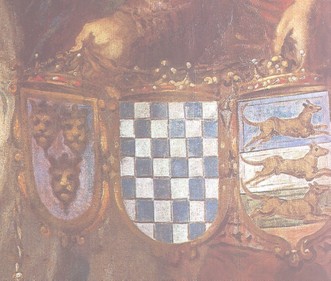
A
detail from the Jesuit Collegium where R.
Boskovic was educated,
17th century, representing coat of arms
of
the Kingdom of Croatia,
Slavonia and Dalmatia,
Boskovic was also a brilliant Croatian Latinist poet. He wrote an extensive scientific epic De solis et lunae defectibus (On Solar and Lunar Eclipse) published in London in 1760. It contains 5570 Latin verses, and was dedicated to the Royal Society of England whose member he was. In the title one can read "Father r. Boskovic, of the Jesuit Order", although at that time it was forbidden for Jesuits to live and work in England. The epic was written in the manner of Roman classics, in dactilus hexameter.
For more information see Latin as literary language among the Croats
When Charles Burney, a well known English musicologist, met Boskovic in Milan, he wrote: ...if all Jesuits were like this father, who uses the higher science and the work of mind to advance science for the happiness of mankind, then it were to be wished that this society were as durable as is this world. Boskovic was buried in the church of S. Maria Podone in Milano.
French astronomer Joseph-Jerome de Lalande wrote the following lines in his book Voyage en Italie:
Le plus grand mathématicen que l'aie connu à Rome est M. Boscovich, alors jésuite: il est né à Raguse en 1711, mais il vint à Rome étant encore fort jeune, et après avoir longtemps professé les mathématiques au collège romain il fut fait professeur à Milan et ensuite à Pavie; mais l'on voyait avec peine des talents supérieurs comme les siens, concentrés dans cette derniére ville; non seulement il n'y a personne en Italie dont les ouvrages soient aussi célàbres dans toute l'Europe que les siens, mais je ne connais pas de géomètre plus spirituel et plus profond que lui. Sa mesure de la terre, son beau traité sur la loi de la pesanteur, ses découvertes sur la lumière et sur diverses parties de la physisque, de l'astronomie, de la géométrie, son poème sur les éclipses, imprimé à Londres, à Venise et à Paris, peuvent doner une idée du nombre et de l'étendue de ses talents; mais il faut l'avoir connu particulérement, pour savoir combien il a de génie, combien son caractère est aimable, sa conversation intéressante, et ses idées sublimes dans tout les genres. En 1773, il a été appelé en France et naturalisé Français. Il est actuellement [1784] à Bassano, occupé à faire imprimer ses nouveaux ouvrages, en cinq volumes.
William Thompson-Kelvin, the English physicist (19/20 centuries), once expressed his opinion that his atomic theory is a pure "Boskovicianism." Still earlier, Sir Humphry Davy, professor of physics and chemistry at the Royal Institution in London from 1802 till 1827, mentioned the name of Boskovic on several occasions in his Diary (Commonplace Book), accepting his atomistic theory. The diary is kept in the archives of the Royal Institution in London. Also a famous Irish mathematician and physicist R.W. Hamilton wrote extensively about Boskovic's theory of forces.
With his theory of forces R. Boskovic was a forerunner of modern physics for almost two centuries. It was described in his most important book Theoria Philosophiae naturalis (Vienna 1758, Venice 1763, London 1922, American edition in 1966).
Werner Heisenberg (Nobel prize for physics in 1932) wrote the following:
Among scientists from the 18th century Boskovic occupies outstanding place as a theologian, philosopher, mathematician, and astronomer. His "Theoria philosophiae naturalis" announced hypotheses which were confirmed only in the course of last fifty years.Indeed, see his graph of regions of attractive and repelling forces between material points (elementary particles), the closest region being repelling, tending to infinity (nuclear force!; see here; published in his Dissertationes de lumine pars secunda, 1748), and the farthest region is repelling, corresponding to gravitational force:

Robert Marsh, the author of Physics and Poets, credits Boskovic with the idea of FIELD. Faraday and others took the idea from him, see here. He was the first to apply probability to the theory of errors. Laplace and Gauss acknowledged their indebtedness to his work which led to the Legendre principle of least squares in statistics (stating that the best fitting line is the one with the smallest sum of squared residuals).
He was also very active in astronomy and diplomacy. A great many letters sent to his sister and two brothers written in Croatian witness that he did not neglect his mother tongue. So in one of his letters he wrote that in one of European cities he saw soldiers - "our Croats" (nase Hrvate). He also wrote poetry. Most of his manuscripts are kept in the special Boskovic Archives in the Rare Books library in Berkeley, University of California, USA:- altogether 180 items and including 66 scientific treatises, plus
- rich correspondence comprising over 2,000 letters, among others with Euler, D'Alambert, Lagrange, Laplace, Jacobi and Bernoulli; he had intense correspondence with his friend Voltaire.
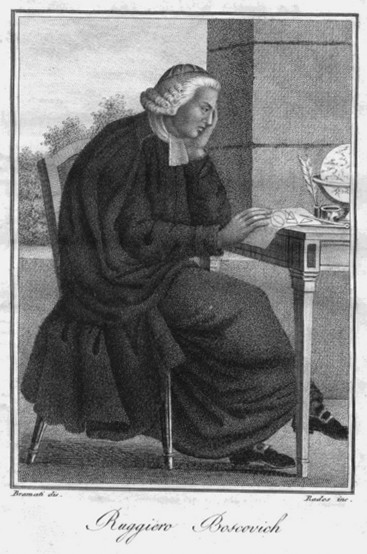
A portrait of Boskovic,
published in Milano in 1818 in a collection of famous
people living between 18th century the beginning of the 19th.
(many thanks to Dr Luca Leoni, Italy, for the photo)
Antun Sorkocevic (Compte de Sorgo, 1775-1841), a good friend of Marko Bruerovic, was the last ambassador of his native Republic of Ragusa in France, where he spent 35 years. Author of numerous publications, he became member of Académie Celtique (1806), Société des Antiquaries (1828). Among other books he published "Mémoire sur la langue et les moeurs des peuples slaves", "Fragments sur l'histoire et la littérature de la République de Raguse et sur la langue slave", translated Ivan Gundulic'es Osman (Osman, poéme illyrien en vingt chants) in 1838.
During
the French occupation in 1808
the Republic of Dubrovnik was abolished, although the Senat refused
such a decision with indignation. On the other hand, it is interesting
to mention René
Bruère Desrivaux
(1736-1817), a
French consul in Dubrovnik about 30 years earlier, who declared: j'aime
les Ragusins comme les Francais.
His son, born probably in Tours or
Lyon, has been completely "ragusinated," and became a ragusin poet - Marko
Bruerovic (~1765-1823). In 1793
he was engaged for 4 years in
diplomatic work in Bosnia
(Travnik) as
commercial attaché. He also helped Jewish merchants in
Sarajevo.
His wife was Katarina Hodic, a Bosnian Croat who gave him two children.
See [Dolbeau],
p 38.
The
name of Katarina is very frequent among the
Croats in central Bosnia. This is related to the last Bosnian Queen Katarina.
Antun Sorkocevic (Compte de Sorgo, 1775-1841), a good friend of Marko Bruerovic, was the last ambassador of his native Republic of Ragusa in France, where he spent 35 years. Author of numerous publications, he became member of Académie Celtique (1806), Société des Antiquaries (1828). Among other books he published "Mémoire sur la langue et les moeurs des peuples slaves", "Fragments sur l'histoire et la littérature de la République de Raguse et sur la langue slave", translated Ivan Gundulic'es Osman (Osman, poéme illyrien en vingt chants) in 1838.
The Dominican convent from 14th century is one of the most beautiful architectural masterpieces of the city. Very famous are paintings by Nikola Bozidarevic (16th century), especially the one in which Sv. Vlaho holds the model of the city in his hands.During the French occupation of the City in the beginning of 19th century the convent served as a stable for horses!
This paragraph is taken from Mr Vicko Rendic web page, where you can find more information.
CROATIAN LATINISTS, HUMANISTS AND ENCYCLOPAEDISTS
Augustin Kazotic, a Dominican from the beautiful city of Trogir (13th century), the future bishop of Zagreb, studied at the University of Paris (Sorbonne) by the end of the 13th century. He was reputed to be "an excellent orator and brilliant diplomat" not only in Croatia, but also in France and Italy. He also founded the important Library of Metropolitana in Zagreb, existing continuously from 13th century to these days. Beatified in 1702.
It seems that Dante traveled through Croatia, and with help of Croatian pilgrim, now a friend and guide through Croatia, Bishop Kazotic, he visited Jurandvor on the island of Krk and saw the Baska Tablet.
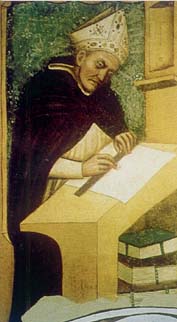
Antun Vrancic (lat Antonius Verantius, hungarized name Antal Verancsics, born in Sibenik in 1504) studied in Padova, Vienna and Krakow. After spending almost 20 years as a secretary and diplomat at the court of Ivan Zapolja, he continued his career at the court of Ferdinand I Habsburg in 1549. As the king's envoy he had a delicate task to negotiate with the Turks (he spent altogether 6 years as a diplomat in Turkey). Together with a Flamish diplomat Busbeck he discovered the Ankara plate (Monumentum ancyranum, held in the National Museum in Vienna), which is quite important for understanding the history of the Roman Empire, especially during the time of the Emperor Augustus. As a diplomat he travelled to France, Italy, Poland, England (on a diplomatic mission to the court of King Henry VIII), Turkey etc., and was exchanging letters with Erasmus of Rotterdam. In Krakow, Poland, he published two collections of poetry in the Latin language ("Elagiae" and "Otia").
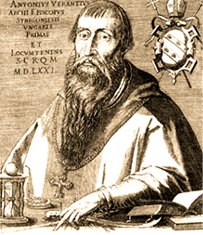
Portrait of Antun Vrancic by
outstanding Croatian painter
Martin
Rota Kolunic from Sibenik

Antun Vrancic, that is, Antal Verancsics, is in Hungarian literature usually described as Hungarian, which is no surprise. The same for Faustus Verancsics, his very famous relative.
It is little known that the famous Venetian painter Tizian portrayed Frane Vrancic - father of Antun Vrancic.
Bartol Kasic (1575-1650), a Croatian Jesuit, was the author of the first Croatian Grammar "Institutiones lingue illyricae", printed in Rome 1604. About the same time he prepared the Croatian - Italian dictionary, which remained unpublished until 1990. In the period of 1631-1636 he translated the whole Bible into spoken Croatian, but unfortunately the book remained only in handwriting. In his "Ritual Rimski" ("Rituale Romanum", Rome, 1640) he cites very old Croatian names for months that are in use even today:
|
- In 1999 we celebrated four centuries of Croatian philology, which has started with Bartol Kasic. His work was very important in standardization of the Croatian language, using the principle "write as you speak".
- He also wrote one of the earliest autobiographic books in Croatia describing the consequences of the Turkish Ottoman occupation. In one of his writings he concludes: I stop here, crying and sighing when I remember all that I saw with my own eyes: profaned churches, settlements completely destroyed, so that nothing was left except tents, hovels, huts. Let God have mercy on us and let him bless us... Let him illuminate us with his Face and Word, and let him have mercy on Croatian people, which is crushed and almost heart-broken.
- In 1612 he opened the gymnasium for the Catholic youth in Belgrade (mostly for children of native Catholics and the Dubrovnik merchants). At that time Belgrade was under the Turks. This was the first gymnasium in Serbia.
- Two samples of Kasic's Cathecism are held in Bibliothéque Nationale (former Bibliothéque Royale) in Paris, France.
- For more information see Vladimir Horvat: Bartol Kasic; cetiri stoljeca hrvatskog jezikoslovlja, Zagreb, 1989. In this book you can also find important information about Dominican Glagolitic priest Beniamin de Croatia.
- It is insteresting that in Kasic's dictionary one can find the name of "tesla", meaning adze. One of grand-grandfathers of the famous inventor Nikola Tesla was Draganic, nicknamed Tesla. I owe this information to dr. Vladimir Muljevic, professor emeritus of the University of Zagreb.
Georges d'Esclavonie (or de Sorbonne, Juraj iz Slavonije, born in Brezice in present Slovenia, 1355/60-1416), a professor at the University of Paris (Sorbonne) and a theological writer, wrote the first Croatian abecedarium of Christian science in the Glagolitic alphabet about 1400 (held in the Municipal Library in Tours). He wanted to show his renowned colleagues of Sorbonne that except Hebrew, Greek and Latin also existed a genuine Croatian alphabet, or alphabetum chrawaticum as he called it, having a great graphic and lexical value. In 1401 he defended his doctorate in theology. In 1403 his name was included in the big scroll of professors of the University of Paris. Since 1404 he was also a canonist-penitentiary in Tours, in the nun's convent Beaumont, until the end of his life. With his book "Le chasteau de virginite", written in Latin and French, he entered the history of French and European literature. There exist many of its copies from the 15th century, plus three French printed editions (1505, 1506, 1510) and one Latin (1726), thus proving its popularity in Europe. His manuscripts, some of them written in the Croatian Glagolitic, are held in the City Library (former Cathedral Library) in Tours. He was also very fond of Istria, to which he referred as a part of his Croatian homeland: Istria eadem patria Chrawati. Photos of some of his manuscripts can be seen at Juraj iz Slavonije (in Croatian). One of his original manuscripts is held at Yale University Library.
Among Croatian Latinists and writers in Croatian a central place is occupied by Marko Marulic, who is the "father of Croatian literature" (born in Split, 1450-1524). He was the most famous spiritual writer of his time in Europe, and also the first who defined and used the notion of psychology, which is today in current use.
His book De institutione bene vivendi (six volumes, 64 chapters), published in Venice in 1506, had fifteen editions until 1686 and was translated from Latin into
- Italian,
- German (five editions between 1583 and 1614, all in Köln, in parts already in 1568),
- French (7 editions, the first in 1585),
- Japanese (in parts, 1585)
- Portuguese and
- Czech,
altogether 40 editions. It is well known that St. Francis Xaver had taken only two books on his long pilgrimage to the East (India, Japan and China): the Bible and De institutione. Furthermore, in his testament St. Francis Xaver asked that Marulic's book be buried with him. Therefore we may conclude that Marulic was a spiritual father of St. Francis Xaver. St. Francis Xaver's personal sample of Marulic's book was kept in Madrid in a collection of valuables until 1937, when it had dissapeared. St. Ignazio Loyola included De Insitutione into the list of basic references for the formation of Jesuits. Both St. Francis Xaver and St. Ignazio Loyola were Basques.
Marulic left us many beautiful verses and the epic poem Judita written in the Croatian language, for which he says expressly to be written in the Croatian verses (versi harvatski). Some of his original verses are held in Glasgow (GB). His Judith was translated into English, Hungarian, French, Italian, and some parts into Spanish. Marulic translated from Latin into Croatian the famous "De imitatione Christi" by Thoma de Kempis.
The original Marulic's manuscript of "De institutione bene vivendi" has been stolen from the Croatian National Library in Zagreb around 1980. Any information about this would be appreciated.
According to investigations of a French specialist Charles Béné, Marulic's texts have been used extensively by Thomas More and Henry VIII. It is known that Marulic's "Evangelistarium" that was read by Henry VIII bears many comments by the King. It is considered that two of the king's three literary works were written under the influence of Marko Marulic. Charles Béné has translated Marulic' Judita from Croatian into French (La Judith).
Marulic's poem "Carmen de Doctrina Domini Nostri Jesu Christi pendentis in cruce" was translated into English as "A Dialogue betwext a Christian and Christ hanging on the Crosse" by Philip Howard, Earl of Arundel (1557-1595).
According to C. Verdiani, Marulic is also the author of the Florence Codex, which contains a biography of St Jerome written in the Croatian language. There he wrote
and a brilliant crown of the Croatian language.
In Croatian: Jerolim je nass Dalmatin, on je dika, posstenje i slava i svitla kruna hrvatskoga jezika.
Marko Marulic sent a dramatic letter to the Pope Hadrian VI, describing an extremely tragic position of the Croats threatened by the onslaughts of the Ottoman Empire and asking for help.
His books were known not only in the whole of Europe, but also in Japan (in the 16th century) and South America. For example, parts of De institutione bene vivendi were translated into Japanese already in 1585.
Alonso de Villegas, Spanish author of a famous book Fructus Sanctorum (printed in Paris in 1624), refers to Marulic's De Institutione on almost every page. Another Spanish Christian humanist, Juan Lorenzo Palmierno (Laurentius Palmyrenus), in four of his texts published between 1564 and 1578 mentions expressly to be inspired by Marulic's books. Moreover, in one of his dramas there is a figure called "Marulus". And Professor Michael Neralich (lecturing Spanish and comparative literature at the University of Clermond-Ferrand) considers that the figure of "Andrea Marulo" in the novel Trabajos de Persiles y Sigismunda by Cervantes is inspired by Marulic. There is no doubt that Cervantes was familiar with Marulic's books, since they were translated into Spanish by Fernandez de Ruenga. In the Library of Cristoph Columbo in Sevilla, founded by Hernando Colon (son of Cristoph Columbo), there are many books by Marko Marulic, and even his "Judita" written in Croatian!
When St. Francis Xaver arrived to Kogoshima in Japan in 1549, he also brought Marulic's "De insitutione bene vivendi". According to bishop Hamao from Yokohama, president of Japanese Bishop's Conference and of Asian Caritas, the formation of earliest Japanese Christians had been very probably based on the spirituality of Marulic. See here (in Croatian). It is interesting that in Berlin a monument of Marko Marulic was set up in 2000. In the Library of Congress, Washington, a symposium was held devoted to his work.
- Marko Marulic, Humanist from Split
- Marko Marulic - Marcvs Marvlvs (in French), by Mirko Tomasovic
- MARVLIANVM, Centar za proucavanje Marka Marulica i njegova humanistickoga kruga, Split
One of the greatest promoters of Protestantism in Europe was Flacius Illyricus (Matija Vlacic, born in Labin in Istria, 1520-1575). As a young Croatian philosopher, at the age of 24 he was appointed to be a professor of Hebrew and Greek at the University of Wittenberg, the center of Protestantism. The bibliography of his work is enormous - three hundred books and brochures. His "Catalogus testium veritatis" (Magdeburg, 1555) represents a tremendous historical documentation, probably the best polemical book of his time. French edition appeared in Strasbourg in 1526 and in Lyon in 1597. His pamphlet "Contre la principauté de l'évêque de Rome" was printed in Lyon in 1563. He wrote also about Croatian churches that ever since had liturgy in the Croatian version of the Old Church Slavonic language, using holly books written in the Croatian Glagolitic Alphabet. He was the organizer, editor in chief and the chief writer of the famous "Ecclesiastica historia" (The History of the Church), that appeared in 13 volumes in Basel. His greatest linguistic work is "Clavis Scripturae Sacrae" (The key to the Sacred Script, it contains about 7.5 million characters), analyzing lexicographically the content of the Old and New Testament. He is considered to be the founder of hermeneutic philosophy. When writing about Istria (peninsula in the Adriatic), he calls it `the sweetest homeland'.
A Croatian Jesuit Mark Antun de Dominis (born as Marko Domnianich on the island of Rab, 1560-1624) ranked among the greatest European philosophers and scientist of his time. His career of a university professor started in Padova. He was especially esteemed in England, where he was invited by king James I. There he lived at the Court of the Archbishop of Canterbury and was appointed to be the Windsor Dean and the king's chancellor.
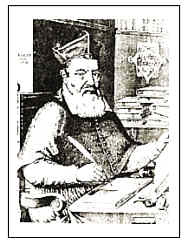
Dominis arrived to London in December 1616 with a great pomp after his apostasy from Rome. Four days after the spectacular welcome, Dominis was placed fifth place next to King James. This meant, according to the protocol of the time, that he was fifth in the hierarchy of the state. In 1617 he was lecturing in Cambridge and Oxford. In Cambridge he was awarded the title of doctor of divinity. His sermons in London were printed in Italian, English and Latin. His book "The Ecclesiastical State" was printed in Latin in England, with permission of the King.
It is interesting that Dominis introduced the word "puritan" into English in its modern meaning, which was earlier used only in theological literature and had a very narrow meaning.
His work in physics was cited in I. Newton's book "The optics" published in 1704 (page 147). Among other things he contributed to the explanation of the phenomenon of the double rainbow. His theory of tides was based on the idea of attractive force between the Moon and the Earth, which was later made precise in Newton's theory of gravitation. He also discovered the phenomenon of diffraction of white light (see G. Hund's "Geschite der Physik"). However, his main preoccupation was the problem of European peace and the reform of the Church. In 1618 his work "The Rocks of Christian Shipwrecke" was printed first in Italian, and then in English. It was held an important apologetic work of Protestant theology, and was soon translated into French. It was read throughout Europe.
After six years of stay in England his relation with the Anglican Church and the King himself cooled down, though he had given the Anglican Church one of the most important doctrinal weapons (for more details see [Mardesic], p. 162).
His work "De Republica
Ecclesiastica", which was published in
ten books in London, brought him the anathema of Rome. He was
imprisoned by Inquisition and when he died, the burial of his body was
not allowed. It was burnt, together with his manuscripts, on the square
of Campo dei Fiori in Rome, where Giordano Bruno had been burnt twenty
four years earlier.
Branko
Franolic: Two Croatian refugees at St.
James’s Court at
the beginning of the 17th century
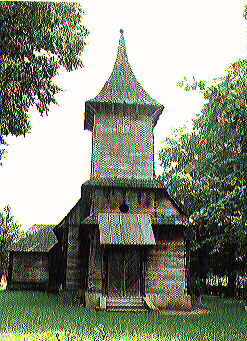 An
extremely interesting biography has Bartol
Gyurgieuits (Bartol Jurjevic or
Gjurgjevic, born in the region of
Turopolje near Zagreb, known for nice wooden churches, 1506 - 1566?), a
participant of the tragic battle on the Mohac field in 1526, where he
was captured by the Turks and lived as a slave in many parts of the
Turkish Empire. After 13 years of slavery he managed to escape. Since
that time he travelled a lot throughout Europe, agitating for the
creation of a strong union against the Ottoman Empire. His numerous
writings in the Latin language were published first in Antwerpen (1544)
and then extensively reprinted in many other languages: Italian,
French, English, German, Spanish, Dutch, Hungarian, Polish, Czech etc.
These extremely interesting testimonies about the Ottoman (Turkish)
Empire can be found in the libraries of almost all larger European
cities:
An
extremely interesting biography has Bartol
Gyurgieuits (Bartol Jurjevic or
Gjurgjevic, born in the region of
Turopolje near Zagreb, known for nice wooden churches, 1506 - 1566?), a
participant of the tragic battle on the Mohac field in 1526, where he
was captured by the Turks and lived as a slave in many parts of the
Turkish Empire. After 13 years of slavery he managed to escape. Since
that time he travelled a lot throughout Europe, agitating for the
creation of a strong union against the Ottoman Empire. His numerous
writings in the Latin language were published first in Antwerpen (1544)
and then extensively reprinted in many other languages: Italian,
French, English, German, Spanish, Dutch, Hungarian, Polish, Czech etc.
These extremely interesting testimonies about the Ottoman (Turkish)
Empire can be found in the libraries of almost all larger European
cities:
Paris, Rome, Vienna, Basel, Leiden, Wittenberg, Florence, London, Prague, Venice, Antwerpen, Liége, Worms, Nürenberg, Krakow, Lyon, Frankfurt etc. (e.g. in 44 towns of Germany alone) and in some cities of the USA.
Most of his writings
contain small dictionaries of the
Croatian (which he calls Slavonian), Turkish, Persian and Hungarian
languages. As a part of his "De afflictione...sub Turcae" (1544) he
wrote the first known Croatian - Latin dictionary (with the basic
prayers: Our Father, such as Hail Mary, Credo), which is also the first
known dictionary among the Croats. He is also the author of the
practical Italian - Arabian - Hebrew - Chaldean dictionary, added to
the description of his pilgrimage to Yerusalem when escaping from the
Turkish slavery. It was written in Italian: "Specchio della
peregrinazione delli piu notabili luoghi della Terra Santa", and the
author signed it as Georgievicz de Croatia. He also mentioned a
Croatian Script, which is "different from any other script in the
world" (Glagolitic).
He indicates that the
Croatian language is spoken among others on the Constantinople court of
Turkish sultans. Gyurgieuivits' works are also of interest for the
study of Islamic
music. He was not only
the first Croatian author, but also the first Slav author whose
writings were popular throughout Europe. For more information see [Zoric].
Branko
Franolic: Georgijevic's Description of Turkish
Ways and Customs:
Unique Work Published in London in 1570
The Englishman Hugh Goughe wrote "The Ofspringe of the House of Ottomane" (1570) which is a translation of Gyurgieuits' book "De origine imperii Turcorum". In Goughe's book there is a dialogue in Croatian with a parallel English translation, alongside with two prayers in Croatian (Our father and Hail Mary). Gyugyieuits himself is called the "first Croatian lexicographer" in this book.
Regarding early dictionaries of the Croatian language, let us mention a German knight Arnold von Harf (1471-1505) who visited the Croatian lands along the coast during his pilgrimage to the Holy Land in 1496-1499. His book "Die Pilgerfahrt des Ritters Arnold von Herff von Cöln", published in Köln in 1860, includes a short conversational dictionary of the Croatian language containing 56 words and basic expressions. He also visited the beautiful, strong and freedom loving city of Dubrovnik (as he says), for which he states to be in the Croatian Kingdom - in den Koenynckrijh van Croatijen.
A significant Croat, born on the island of Hvar, very little known even among the Croats, was Ivan Franje Bjundovic (Giovanni Francesco Biondi, 1573-1645). After having met Sir Henry Watton, English ambassador in Venice, with whom he shared the same interests as a lawyer and literature fan, he journeyed to England and carried confidential messages to King James I. Obviously, he was considered a competent scholar and diplomat, since James himself entrusted him with important diplomatic missions.
Bjundovic wrote a trilogy in Italian: "Eromena", "La danzella desterrada" and "Il Corlabo", which had several editions. Their English translations enjoyed exceptional popularity, as well as German and French. His most important work is "History of the English Civil Wars", with his name appearing as Sir Francis Byondy. It was published in three volumes, where he described the Wars of the Roses. It was first published in Italian (L'istoria della Guerre civili d'Inghilterra) and printed in Venice in 1637-1644. Its English translation started to appear in 1641.
The Illyrian (Croatian)-French dictionary, prepared by Sime Starcevic (from Udbina in Lika), has been published by the French rulers in Trieste in 1812.
Dragutin Antun Parcic (1832-1902) was a Glagolitic priest, linguist, philologist, and lexicographer born in the lovely town of Vrbnik on the island of Krk, important site of Croatian Glagolism. He wrote extensive Croatian - Italian and Italian - Croatian dictionaries ("Rjecnik ilirsko - talijanski," Zadar, 1858, its last edition was printed under the title "Rjecnik hrvatsko - talijanski," 1901; "Vocabolario Italiano - Slavo," Zadar 1858-68). His 1901 dictionary contains 90,000 words on 1200 pages. He also published a grammar of the Croatian language in Italian: "Grammatica della lingua slava (illirica)", Zadar 1873. Only four years later it was translated into French, but under the title "Grammaire de la langue Serbo-Croate" (!) (Paris 1877, Paris 1904). It is little known that he introduced the name of BRZOGLAS for telephone in his dictionaries (Anic's contemporary dictionary claims in all its four editions that "brzoglas" is an NDH neologism, which is not true). His probably most interesting work is the Glagolitic Missal that he prepared for the needs of the Croatian Glagolitic Liturgy, published in Rome in 1893. See an article by Igor Gostl for more details (in Croatian), or his book.
After 1945 Zagreb was again the center of encyclopaedic activity, as a continuation of a very long tradition, with many publications and books being issued during the past 40 years. Here we should mention Miroslav Krleza (1893-1981), one of the most outstanding Croatian writers of the 20th century. The famous French writer Jean Paul Sartre admitted that Krleza has anticipated his idea of the "nausée". During many years Krleza was the president of the Yugoslav Lexicographical Institute in Zagreb (today Lexicographical Institute Miroslav Krleza) and editor in chief of the Encyclopaedia of Yugoslavia. He also signed the important Declaration about the Name and Position of the Croatian language in 1967. At this moment a project is initiated that should result in a new Croatian Encyclopaedia.
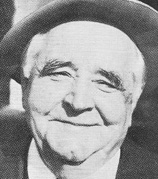
Five centuries of the Croatian lexicographic work can endure any serious critical judgement, which ranks it to the highest achievements of European lexicography (Igor Gostl). This unusual situation is especially striking in view of the fact that the Croats represent a small European nation.
The Croats organized all the expositions of the (ex)Yugoslav art in Paris:
- in Petit Palais (1919) by Ivan Mestrovic,
- in Palais de Chaillot (1950, L'art médiéval yougoslave) by Miroslav Krleza,
- in Grand Palais (1971, Huit millénaire d'art en Yougoslavie) by Miroslav Krleza, which received 150,000 visitors; it has been considered as "l'événement de la saison" in Paris.
An exposition of the French art has been organized in Zagreb in 1940.
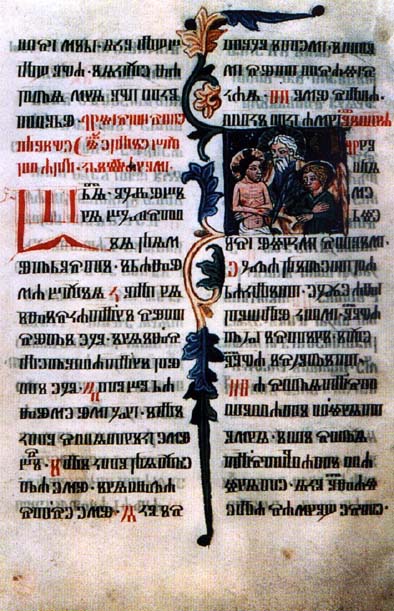 The
famous Czech
king Charles IV of Luxemburg built a Glagolitic
convent Emaus (na
Slovaneh) in Prague in 1347,
where eighty Croatian Benedictines
from the island of Pasman and Senj were invited. It is remarkable that
the convent is not far from the famous Charles University, built the
next year, in 1348 (Charles IV also founded the University of Vienna in
1365). One of the Glagolitic books from this convent (Emaus) in Prague
came to Reims in 1574, where according to a legend for centuries the
French kings (Charles IX, Henri II, Louis XIII, Louis XIV) were sworn
in by putting their hands on this holy book, known under the name Texte
du Sacre or L'Évangile
de
Reims.
This Glagolitic book was written in 1395, and represents
a copy of an older Croatian book, written probably in Omisalj. In fact,
the Glagolitic book was bound together with a Cyrillic book which is of
the Ukrainian (Ruthenic) provenance, written in Kiev, and dates from
the 12th century (the Cyrillic part has 16 leaves, and the Glagolitic
part has 31 leaves). The book was ornamented with gold, precious stones
and relics, and according to [Dolbeau],
p
26-27, probably calligraphed on the island of Krk or in a Czech
monastery. These Dolbeau's pages are available here.
The
famous Czech
king Charles IV of Luxemburg built a Glagolitic
convent Emaus (na
Slovaneh) in Prague in 1347,
where eighty Croatian Benedictines
from the island of Pasman and Senj were invited. It is remarkable that
the convent is not far from the famous Charles University, built the
next year, in 1348 (Charles IV also founded the University of Vienna in
1365). One of the Glagolitic books from this convent (Emaus) in Prague
came to Reims in 1574, where according to a legend for centuries the
French kings (Charles IX, Henri II, Louis XIII, Louis XIV) were sworn
in by putting their hands on this holy book, known under the name Texte
du Sacre or L'Évangile
de
Reims.
This Glagolitic book was written in 1395, and represents
a copy of an older Croatian book, written probably in Omisalj. In fact,
the Glagolitic book was bound together with a Cyrillic book which is of
the Ukrainian (Ruthenic) provenance, written in Kiev, and dates from
the 12th century (the Cyrillic part has 16 leaves, and the Glagolitic
part has 31 leaves). The book was ornamented with gold, precious stones
and relics, and according to [Dolbeau],
p
26-27, probably calligraphed on the island of Krk or in a Czech
monastery. These Dolbeau's pages are available here.
Precious stones, relics, and a part of the true Cross disappeared from the cover of the book during the French revolution. See [Gregory Peroche], p. 62.
Let us cite the following passage from [Castellan, Vidan, p. 31]:
..Selon divers récits, l'Évangéliaire aurait servi lors du sacre des rois de France, notamment ceux de Francois II et Charles IV, puis d'Henri II, Louis XIII et Louis XIV qui "posèrent la main sur son texte en pronoçant la formule du serment" (L. Paris).
In 1485/46 a French pilgrim Gheorge Langherand wrote that in Zadar he heard a "Sclavonic" sermon, that is, a Croatian Glagolitic mass. In 1549 a French Franciscan and cosmograph Andre Thevet noted the prayer "Oce nas" (Our Father) in Croatian language. See [Raukar], p. 360.
Croatian Glagolitic Script and France
Hrvatsko-francuski glagoljaski dodiri [PDF]
 It
is interesting
that a table of the Glagolitic Script was included as early as in 1664
in a book prepared by Richard
Daniel and published in London.
It represents a catalogue of various Scripts in use in the Christian
world. The Glagolitic Script presented there is called expressly the Croatian
hand or Alphabetum
Charvaticum. The book contains
also the
table of Croatian
glagolitic quick-script,
which Daniel calls Sclavorum
Alphabetum, and Croatian - Bosnian
cyrillic
(many thanks
to Professor Ralph
Cleminson for this information).
The book is
entitled
It
is interesting
that a table of the Glagolitic Script was included as early as in 1664
in a book prepared by Richard
Daniel and published in London.
It represents a catalogue of various Scripts in use in the Christian
world. The Glagolitic Script presented there is called expressly the Croatian
hand or Alphabetum
Charvaticum. The book contains
also the
table of Croatian
glagolitic quick-script,
which Daniel calls Sclavorum
Alphabetum, and Croatian - Bosnian
cyrillic
(many thanks
to Professor Ralph
Cleminson for this information).
The book is
entitled
Also a renowned French polyhistorian and encyclopaedist Guillaume Postel included a table of this script (which he calls Alphabetum Hieronymianum seu Dalmaticum, aut Illiricum) in his book Linguarum duodecim characteribus differentium alphabetum ([pdf] at Bibl. Nationale, Paris) published in 1538. Here is Postel's Glagolitic table: [pdf].
The French Encyclopedie by Diderot and D'Alambert from 1751 has a table and a short description of the Glagolitic script, called Ilyrien ou Hieronimite (in section Alphabets anciens). This enabled wide European cultural circles to be better acquainted with this exotic script (...Les caracteres illyriens sont singuliers et on y remarque trés peu de rapport avec les alphabets que nous connaissons...). For more information see [Hercigonja: Na temeljima hrvatske knjizevne kulture, pp 49-56].
France: Paris, Reims, Tours, Strasbourg
 pelling
of Glagolitic Letters, with the
corresponding numerical values, according to George
d'Esclavonie (Juraj iz
Slavonije, ~1355-1416), Glagolitic priest
and university professor on Sorbonne in Paris (his manuscripts are held
in the Municipal library in Tours, France; in his accompanying text he
wrote: Istud
alphabetum est Chrawaticum
-This is a Croatian Alphabet):
pelling
of Glagolitic Letters, with the
corresponding numerical values, according to George
d'Esclavonie (Juraj iz
Slavonije, ~1355-1416), Glagolitic priest
and university professor on Sorbonne in Paris (his manuscripts are held
in the Municipal library in Tours, France; in his accompanying text he
wrote: Istud
alphabetum est Chrawaticum
-This is a Croatian Alphabet):
|
|
One of preserved manuscripts of George de Sorbonne is held in the Municipal Library of Tours, France. It contains standard prayers like:
in beutiful Glagolitic handwriting, and with his translation into Latin. He refers to Istria as his Croatian homeland: Istria eadem patria Chrawati. My deepest gratitude go to academician Franjo Sanjek and dr. Dragica Malic for their studies about George (Juraj), and for facsimiles.
![]()
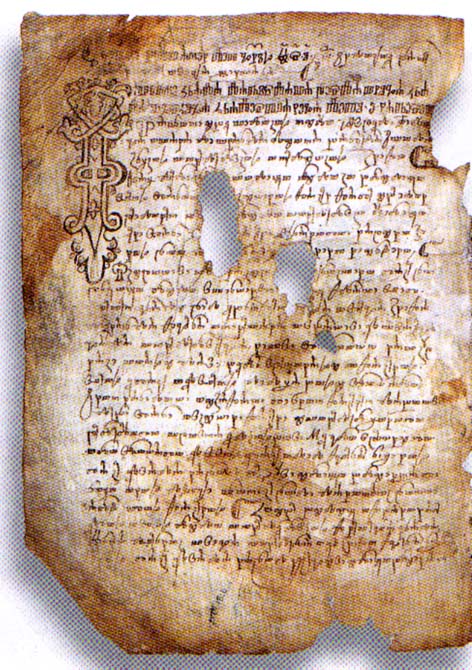 ne
of the earliest and most
important Croatian legal documents is The
Vinodol Code, very different
from the Roman law, written in the
Glagolitic alphabet in 1288. It also introduced the institution of
witnesses. It was unique in Europe by determining moral protection and
integrity of women. The Vinodol Code does not allow torture during
legal proceedings, and is considered to be one of the most important
documents of medieval Europe. Among the Slav Codes only the Rus'
Code "Pravda" is slightly older
(1282). The first Croatian edition
of the Vinodol Code was published in Zagreb in 1843. Two of its Russian
translations with comments were issued soon after: in Moscow in 1846
and in St. Petersburg in 1878. A translation of the Vinodol Code into
Polish appeared in 1856 and into French in 1896 (Jules Preux: La Loi du
Vinodol traduite et annotée // Nouv. rev. hist. du droit
français et étranger. - 1896). The code was
published in
many European countries: it was translated into at least nine
languages. For more information see here,
and at the Croatian National and University
Library in
Zagreb.
ne
of the earliest and most
important Croatian legal documents is The
Vinodol Code, very different
from the Roman law, written in the
Glagolitic alphabet in 1288. It also introduced the institution of
witnesses. It was unique in Europe by determining moral protection and
integrity of women. The Vinodol Code does not allow torture during
legal proceedings, and is considered to be one of the most important
documents of medieval Europe. Among the Slav Codes only the Rus'
Code "Pravda" is slightly older
(1282). The first Croatian edition
of the Vinodol Code was published in Zagreb in 1843. Two of its Russian
translations with comments were issued soon after: in Moscow in 1846
and in St. Petersburg in 1878. A translation of the Vinodol Code into
Polish appeared in 1856 and into French in 1896 (Jules Preux: La Loi du
Vinodol traduite et annotée // Nouv. rev. hist. du droit
français et étranger. - 1896). The code was
published in
many European countries: it was translated into at least nine
languages. For more information see here,
and at the Croatian National and University
Library in
Zagreb.
The Statute of the Poljica Principality
(1444, near Split),
written in the Croatian
Cyrillic Script. The
Poljica Principality (Poljicka knezija) was a unique phenomenon in
Europe. It existed continuously for almost seven centuries, with its
own very original legal system. Russian scientist P. Alexeev believes
that Thomas More wrote his ``Utopia (The Perfect State)'' (Louvain,
1516) inspired by the Poljica Principality. Thomas More calls Poljica
man - Poly(it)eritu, i.e. those who use more scripts (3 scripts:
Glagolitic, Cyrillic, and Latin). Legend has it that the Principality
was founded by three sons of dethroned Croatian king Miroslav in the
mid 10th century. It was abolished during the French rule in 1807. As
remarked by scientists already in the 19th century, the "Poljica
Statute" is very closely related to the above mentioned Ruskaya Pravda,
though they appeared in very distant areas (Kiev and Dalmatia). See [Pascenko],
p. 272.
One
of the items of Poljica statute is that
"everybody has the right to live," contrary to many medieval European
laws replete with punishments involving torture. Thomas More added to
the 1516 edition of his Utopia a frontispiece showing 4 lines in the
Utopian language and Utopian alphabet. According to Alexeev, those who
know Glagolitic script, at a first glance cannot resist the idea that
``some letters in these four lines are in fact written in the
Glagolitic script'' (see [Mardesic],
p. 147).
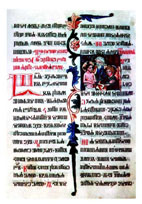 If
you live in Prague,
then you can see about 20 Croatian
Glagolitic manuscripts from 14th to 15th centuries in the library of
Narodni Muzeum. In "Narodni a univerzitetni knihovna" (National and
University library) you can see the Kirin
Croatian Glagolitic
psalter, known also as Lobkowitz
Glagolitic psalter, according to
one of its proprietors in Czechia (1359), written by Kirin from Lika -
Krbava region. The National library also has a monumental Czech
Glagolitic Bible from 1416
(38x29 cm), where the copyists found it
important to state that "the book was was not written by Croat monks,
but by Czech monks". The Bible written in the Czech Church Slavonic
language and in Croatian Glagolitic is an interesting trace of Croatian culture in Czechia.
If you visit
an important Czech benedictine convent of Sazava (now museum) built in
11th century, 60 km from Prague, then you will have opportunity to see
a room dedicated to the activities of Croatian benedictines in Prague
in 14th century. There we can read that Évangelier
de Reims (or Texte du Sacre,
written by Croatian monks in Prague in
1395), was a book with which for centuries French kings were sworn in.
One of them was Louis XIV. More about this book can be seen here.
If
you live in Prague,
then you can see about 20 Croatian
Glagolitic manuscripts from 14th to 15th centuries in the library of
Narodni Muzeum. In "Narodni a univerzitetni knihovna" (National and
University library) you can see the Kirin
Croatian Glagolitic
psalter, known also as Lobkowitz
Glagolitic psalter, according to
one of its proprietors in Czechia (1359), written by Kirin from Lika -
Krbava region. The National library also has a monumental Czech
Glagolitic Bible from 1416
(38x29 cm), where the copyists found it
important to state that "the book was was not written by Croat monks,
but by Czech monks". The Bible written in the Czech Church Slavonic
language and in Croatian Glagolitic is an interesting trace of Croatian culture in Czechia.
If you visit
an important Czech benedictine convent of Sazava (now museum) built in
11th century, 60 km from Prague, then you will have opportunity to see
a room dedicated to the activities of Croatian benedictines in Prague
in 14th century. There we can read that Évangelier
de Reims (or Texte du Sacre,
written by Croatian monks in Prague in
1395), was a book with which for centuries French kings were sworn in.
One of them was Louis XIV. More about this book can be seen here.
Croatian glagolitic in Czechia (in Croatian)
Citizens of Paris can see several Croatian Glagolitic collections in Bibliothéque Nationale. Two exceptionally important Glagolitic codices are held there: Code Slave 11 (14th century) containing the oldest known collection of Croatian religious lyrics, and Liber horarum (1317). Simun Kozicic Benja, the Krbava-Modrus bishop, founded his glagolitic printing house in the town of Rijeka in 1530. One of 6 published books was Knizice krsta, printed in 1531. Only two copies exist today: one in Paris (Bibliothéque Nationale, sign. 49.052), and the other in Sankt Petersburg (The State Library, sign. No 3093). The only copy of the earliest printed book in the Croatian Cyrillic (1512, prepared by Franjo Ratkovic from Dubrovnik) is also held in Bibliothéque Nationale.
Hrvatska glagoljička kultura i dodiri s Francuskom
Besides Lukacic, Vinko Jelic (1596-1636) was the most important representative of Croatian church music of the time. He was born in Rijeka, and died in Alsace in France (Zabern). This Early Baroque composer is noted for introducing new techniques like chromatics and sequences into his music, which have just begun to appear in Europe. In 1622 he published a collection consisting of 24 motets (plus 4 other pieces) Parnassia militia in Strassbourg.
Ivan Mane Jarnovic (Italianized name Giornovichi, 1740-1804) was an outstanding Croatian violinist and composer of the 18th century, probably from Dubrovnik. He had a true European career - playing, composing and conducting in France (Paris), Austria, Germany, Switzerland, Poland, Scandinavian countries, England. Also played the first violin in the orchestra of the Russian empress Katarina II. Jarnovic composed about 50 chamber instrumental pieces, 22 violin concerts (17 preserved), and is known for having introduced the romanza as a slow movement into the structure of the violin concert. His life is described in a novel Jarnowick by G. Desnoisterres - Le Brisoys, Paris 1844, and in a collection Scènes de la vie d'artiste by P. Smith (Une leçon de Jarnovic, Paris, 1844).
Franjo Dugan (1874-1948), studied mathematics and physics, and was outstanding organ player and composer, the Zagreb Cathedral organist since 1910. See his short biography at A Directory of Composers for Organ, provided by John Henderson (of the Royal Society of Church Music, UK). It is maybe worth mentioning that the French pianist Alfred Brendel, at that time 10 years old, met Dugan in Zagreb, who gave him lessons that he found extremely useful.
Berislav Klobucar (1924), one of the greatest Croatian conductors, born in Zagreb, student of Lovro pl. Matacic, started his impressive career leading the Zagreb Philharmonic Orchestra.
- He conducted the Vienna State Opera for more than forty years (1133 performances in 56 operas!).
- During ten years Klobucar directed Symphonic Orchestra and the Opera in Graz, Austria.
- During nine years he was director of the Opera of Stockholm, Sweden.
- During six years Berislav Klobucar was director of Opera and Philharmonic Orchestra in Nice, France.
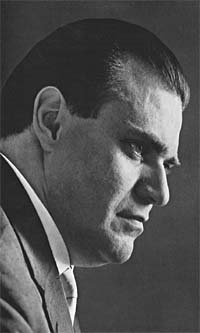
Croatian cultural society Napredak (Progress) from Sarajevo, capital of Bosnia - Herzegovina, has a nice mixed choir called Trebevic. During the 1992-95 ferocious bombing of the city of Sarajevo, they gave numerous concert in the ruined city (in conditions that are difficult to describe), as well as 30 concerts in France, including Notre Dame in Paris. Napredak also organized very successful postwar international concerts in Sarajevo, starting from 1998.
Katarina Livljanic founded a French internationalDialogos Ensemble in Paris in 1996. This vocal ensemble has singers from Norway, Venezuela, Bulgaria, Sweden, France and Croatia, specialized for Middle Age music and liturgical tradition among Mediterranean cultures. Their program includes also old Croatian glagolitic singing from Istria and very archaic singing from the island of Hvar. The glagolitic chant from medieval Croatia has been performed and recorded with great musicological interest.

![]()
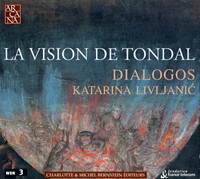
Photos from www.ensemble-dialogos.org
In 1999 a CD Terra Adriatica was issued, under the title Chants sacrés des terres croates et italiennes au Moyen-Age, Dialogos Ensemble/Katarina Livljanic, Paris, ED 13107. The ensemble has won prestigious awards of French critiques like Diapason d'or and Monde de la Musique.
Example: Puce moj [mp3], that is, Popule meus, from Poljica.
Katarina Livljanich is lecturing Middle Age music at Sorbonne in Paris. In 1998 she founded a department for interpretation of Gregorian coral at the University of Limerick, Ireland, which is one of very rare in the world. Since 2002 she is artistic adviser of the Festival of Early Music in Utrecht, the Netherlands.

![]()

- Dialogos - ensemble vocal de musique médiévale, direction: Katarina Livljanic (official web site)
- CHANTS GLAGOLITIQUES, Dialogos en concert "Terra Adriatica", chants sacrés des terres croates et italiennes au Moyen âge
- La Vision Tondale, deux concerts à Paris au Musée Nationale de Moyen-Âge, 2003, see La Vision de Tondal, Dialogos, Katarina Livljanic, CD information
Postal address: Compagnie Dialogos 137 avenue de Choisy 75013 Paris - France Tel/fax: +33. 1. 45.53.40.00 E-mail: dialogos@wanadoo.fr
D I A L O G O S
Ensemble vocal féminin
A l'église St. Louis en l'île (Paris), le 26. octobre 2001, à 20 heures, le groupe vocal féminin Dialogos, sous la direction de Katarina Livljanic, donera un concert de l'ancienne musique vocale sacrale croate.
Dialogos Ensemble vocal
féminin:
Siri Johansen, Christine
Laveder, Lucia Nigohossian, Cornelia
Schmid, Sandrah Silvio, Aurore Tillac, Katarina Livljanic (direction)
La Vision de Tondale.
La musique des chantres dalmates au Moyen Age
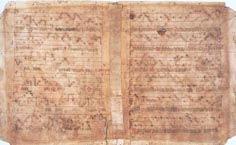 Après
Terra adriatica, l'ensemble féminin de la Compagnie Dialogos
propose une nouvelle étape de sa recherche sur des
répertoires médiévaux très
peu connus.
Concentré cette fois uniquement sur la côte
croate, le
pays qui reçut au XIe siècle la marque du grand
couteau
de schisme entre Rome et Byzance, ce programme essaie d'explorer les
couches plus profondes de ce qu'on appelle le chant
glagolitique, comme un des
visages de la musique croate au Moyen
Age.
Après
Terra adriatica, l'ensemble féminin de la Compagnie Dialogos
propose une nouvelle étape de sa recherche sur des
répertoires médiévaux très
peu connus.
Concentré cette fois uniquement sur la côte
croate, le
pays qui reçut au XIe siècle la marque du grand
couteau
de schisme entre Rome et Byzance, ce programme essaie d'explorer les
couches plus profondes de ce qu'on appelle le chant
glagolitique, comme un des
visages de la musique croate au Moyen
Age.
Ce répertoire liturgique du rite romain, chanté cependant en langue vernaculaire locale au cours du Moyen Age, fut conservé, souvent sans notation musicale, dans les livres en alphabet glagolitique, propre à la Croatie médiévale. Les manuscrits musicaux médiévaux qui transmettent les mélodies de la liturgie glagolitique sont rares. En revanche, nous possédons des textes liturgiques en alphabet glagolitique, et quelques notations musicales qui témoignent de l'existence de ce chant dans la région au moyen age.

![]()

Le fait les plus fascinant est l'existence même des livres liturgiques entièrement écrits en langue vernaculaire (slavon de rédaction croate) dans le monde de la liturgie latine occidentale. Or, la particularité du répertoire glagolitique est sa vie dans la transmission orale qui nous la fait parvenir, jusqu'à aujourd'hui, dans de nombreuses localités sur la côte croate, sur les îles, en Istrie. Ce travail est donc un travail de reconstruction musicale : les connaissances sur le chant grégorien et bénéventain en Dalmatie médiévale, les manuscrits qui transmettent ces répertoires, les manuscrits glagolitiques et la survivance de ces répertoires dans la tradition orale ont guidé les recherches sur la sonorité de ce programme.

Photo from www.ensemble-dialogos.org
Example: Puce moj [mp3]
(Popule meus, from Poljica)
Mais, remontons le temps pour comprendre ce curieux phénomène musical et liturgique : La ville de Zadar reçut en 1177 une visite papale un peu inattendue. Pour échapper d'un orage sur la mer, Alexandre III arriva à Zadar, accueilli par le peuple chantant "in eorum sclavica lingua", comme le témoigne son chancelier, le cardinal Boson. Un peu plus tard, en 1248, le pape Innocent IV accepte, prié par l'évêque de Senj Filip (Philippe), l'usage des livres en écriture glagolitique et de la langue croate dans la liturgie, dans les régions où ils étaient déjà accoutumés. Dans sa demande Filip mentionne que cet alphabet est un héritage qui remonte à saint Jérôme et qu'il est utilisé dans la liturgie. Il s'agit bien-sûr d'une légende - l'écriture glagolitza date du 9e s. et est liée à saint Cyrille et Méthode qui l'aurait composée avant le voyage d'évangélisation parmi les slaves de Moravie. Comme les rapports avec l'autre côte de la mer Adriatique furent très forts et la Croatie appartenait au rite romain, la présence du chant grégorien dans la liturgie locale fut aussi très importante, surtout dans les villes.
Dès les Xe et XIe siècles, les livres liturgiques latins avec notation neumatique sont écrits dans les scriptoria de la côte dalmate, par les mêmes mains des scribes qui copiaient les livres glagolitiques. C'est justement cette ligne de frontière entre les influences latines et les racines traditionnelles qui nous intéresse dans ce programme.
La côte croate est très longue. Bordée de nombreuses îles, ces petits mondes isolés sur lesquels les gens parlent parfois des dialectes différents malgré la distance qui leur permet de crier d'une rive à l'autre et de s'entendre, elle cache des mondes musicaux très différents. Nous confrontons ainsi les mélodies d'Istrie (la messe traditionnelle du village Mune), rudes dans leur polyphonie primitive, les lectures très proches des tons grégoriens (la lecture de l'Apocalypse de Poljica) avec des polyphonies plus « suaves » du sud croate.
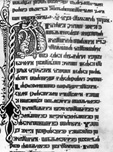 Les
pages choisies du répertoire glagolitique de quelques
localités différentes sont mises dans ce
programme dans
le contexte des répertoires grégoriens et
polyphoniques
parents. Il m'a semblé très précieux
de souligner
ces deux facteurs de la vie liturgique en Dalmatie et Istrie au Moyen
Age. Ainsi, le langage musical de ces polyphonies est souvent primitif,
émanant presque des pratiques musicales traditionnelles et
nous
reconnaîtrons certaines sonorités très
proches
entre les pièces glagolitiques et celles-ci.
Les
pages choisies du répertoire glagolitique de quelques
localités différentes sont mises dans ce
programme dans
le contexte des répertoires grégoriens et
polyphoniques
parents. Il m'a semblé très précieux
de souligner
ces deux facteurs de la vie liturgique en Dalmatie et Istrie au Moyen
Age. Ainsi, le langage musical de ces polyphonies est souvent primitif,
émanant presque des pratiques musicales traditionnelles et
nous
reconnaîtrons certaines sonorités très
proches
entre les pièces glagolitiques et celles-ci.
Et tout au long de ce parcours musical nous reconstruisons une histoire, telle quelle aurait pu être contée aux hommes médiévaux dans des églises dalmates, au travers d'un texte conservé dans le recueil croate Vartal du XVIe siècle. Il s'agit de la Vision de Tondale, récit de l'homme qui visite l'enfer guidé par un ange, qui se perd sur les chemins inconnus, qui traverse les ponts dans l'obscurité, et qui crie sans cesse « pourquoi sommes-nous venus ici ? » Mais l'idée de ce programme nest pas de faire entendre le chant glagolitique tel qu'il résonne encore aujourd'hui parmi les chantres traditionnels. Si lon avait ce but, il aurait été beaucoup plus naturel d'enregistrer tout simplement les chantres des îles dalmates. La vision de Tondale est un voyage vers le chant glagolitique d'autrefois, dans les périodes où les chantres luttaient pour leur langage et musique, quand les mêmes églises possédaient les manuscrits latins et glagolitiques.

Photo from www.ensemble-dialogos.org
Nous n'essayons pas d'imiter les chantres d'aujourd'hui, nous essayons de réveiller les chantres médiévaux, ces hommes doués d'un curieux bilinguisme musical. Cependant, posséder un manuscrit médiéval de chant glagolitique, ou l'édition de cette musique, est comme de retrouver le manuel de quelqu'un qui parlait, il y a des siècles, une langue qui nous est étrangère - nous aurions le livre, mais nous aurons perdu le propriétaire du livre, et nous ne connaîtrons jamais la mélodie de cette langue dans son état originel.

Katarina Livljanic
photo from www.ensemble-dialogos.org
Le chant glagolitique est comme une « musique ancienne » qui na jamais eu le temps de devenir ancienne car elle résonne toujours dans les ruelles et les églises dalmates durant des siècles, sans être jamais obligée de se taire. Le répertoire que nous chantons fait penser aux moments qu'on passe à regarder les corps célestes, éloignés de nous plusieurs centaines d'années de lumière. Nous voyons en fait une image « historique » des étoiles à cause de la distance et du voyage que leur lumière doit faire pour arriver à nos yeux. L'Existence du chant glagolitique sur la côte dalmate est peut être un phénomène semblable. La sonorité que nous entendons est à la fois présente et éloignée, comme une vieille photographie des ancêtres qui ont survécu à travers les siècles sans nous l'avoir jamais avoué.
distributed by CROWN
(Croatian World Net)
AMCA-France; on this web with kind
permission of dr. Katarina Livljanic
ASSOCIATION DES ANCIENS ETUDIANTS ET DES AMIS DES UNIVERSITES CROATES
The story of Tondal, where an unconscious man has a journey where his soul leaves the body, was written in the 12th century by the Irish monk Marcus. It spread across the face of Europe, including a late Medieval version dedicated to Benedictine nuns on the Dalmatian coast. This performance uses Gregorian, Beneventan, and Glagolithic chant known in Medieval Dalmatia. Glagolitic liturgy is in the vernacular Croatian-Slavonic, but follows the Roman Catholic rite of mass.
These performances from the Holland Festival of Early Music at Utrecht 2002 are by the Ensemble Dialogos directed by Katarina Livljanic. They are supported in part by Radio Nederland and the Royal Netherlands Embassy in Washington, D.C.
VISION OF TONDAL
- Invocation to Tondal: Gospodin, smiluj se/Kyrie eleison (Glagolitic). Zac noge tvoje sada u tanci ne igraju.
- The soul of the Knight Tondal descends into Hell: Introit: Venite, benedicti patris mei (Beneventan). Tractus: Qui habitat in adiutorio altissimi (Gregorian, from the "Dubrovnik Missal" in the Bodelian Library, Oxford).
- The Valley of Abomination: Viruju u jedinoga boga/Credo (Glagolitic). Gospodine, pomiluj/Kyrie eleison (Glagolitic).
- Into the depths: Gospin plac (Lament of the Virgin--Glagolitic).
- Lucifer, lord of Hell: O janjce bozji/Agnus Dei (Glagolitic).
- The Golden Seats [After Tondal has followed the angels into hell and walked the thin bridge across the stinking chasm, he sees the golden throne, and wonders why he cannot sit] Obrativ se Tondal za angelorum. Citanje knjige Otkrivenja (Glagolitic--book of the Apocalypse). Dodji, duse presveti/Veni, sancte spiritus (Glagolitic).
- The Knight's Soul returns to his body [When Tondal awakens, he assumes he has been gone for years, only to find all his adventures lasted less that one-millionth of a second] Cuvsi toj; Salve Regina; I toj reksi vaze ga za ruku; Svet/Sanctus. Acclamation: Exaudi Christe.
distributed by CROWN (Croatian World Net)
Related links:
- Pasionska bastina
- Za Krizem - Glagolitic chant for Holy Week from Hvar, Croatia, written by William Hedley
Zvjezdice (Little Stars), all girls' choir, founded in 1985 in Zagreb, conducted by Mr. Zdravko Sljivac, became two-times world champions of the Llangollen International Music Festival of choir music (Llangollen International Musical Eisteddfod), Llangollen, Wales, UK, in 2001, and Outstanding Prize at Sligo Choral Festival in Ireland. They are often compared with the Vienna Boys Choir. Little Stars were elected as Cultural Ambassadors of the European Union Parliament. They had very successful concerts in Norway (Oslo, Stavanger), France (Paris, Nantes, Auxerre), Italy (Milano, Riva del Garda), Switzerland (Zürich), Germany (Füssen), Bosnia and Herzegovina (Sarajevo), Austria (Salzburg), USA (New York, Pittsburgh, Dayton, Northern Kentucky, Cincinatti, Pittsburgh, Cleveland, Los Angeles, Chicago), etc. You can listen to their singing of Croatian Christmas Songs. Maestro Zdravko Sljivac conducted also the World Children Choir in Paris.
Examples of Croatian Christmas carols :
- Radujte se narodi (Rejoice, peoples) [mp3]
- Svim na Zemlji mir veselje (Peace and joy to all on the Earth) [mp3]
Accordcase is important equipment for every cellist, guitarist, hornest etc. The best, ultralight (3-5 kg) accordcases have been designed using carbon fibre technology by Mr. Robert Schenk in Pula, Croatia. These cases are used by many outstanding musicians, like Rostropovic, Sting, Santana, to name just a few. Many thanks to Mr. Nenad Bach for this information.
In 1999 Croatian pop singer Tereza Kesovija received an important French recognition Chevalier des Arts et Lettres for contributions to culture. On behalf of the French president Jacques Chirac it was presented by Jean-Jacques Gaillarde, French Ambassador in Croatia. She is known in Croatia and France for her promotion of the French chanson. At the Grand Prix Eurovision Contest held in 1966 she represented Monaco. Tereza will be remembered also for her numerous humanitarian concerts during the 1991-1995 aggression on Croatia, held not only in her homeland, but also in central Bosnia (Nova Bila). Her house in native Konavle near the City of Dubrovnik was ravaged by Serbian and Montenegrin troops. Very rich personal archives and valuable concert piano were burnt down.
Dunja Rajter (Dunja Reiter) is a well known Croatian singer and actress living in Germany. She was very much involved in humanitarian help to her homeland during Greater-Serbian aggression in 1991-1995.

Dunja Rajter (photo by dpa)
She was the only European singer invited by Harry Belafonte to his american TV-Show where she appeared by such artists like Paul Newmann, Bill Cosby, Diahann Carroll and by Senator Robert Kennedy. Also the French public knows her from very popular Tele dimanche and from the Midi` Magazin.
Biserka Cvejic (r. Katusic) (1923), opera singer, laureate of the French Legion of Honor in 2001
Illma de Murska (born as Ema Puksec in the town of Ogulin, 1834 - 1889) was an opera diva of international fame. She sang in Italy, Spain, Hungary, and her most fruitful period was in Vienna, Austria. She also sang in Berlin, Hamburg, Paris and London, and had tours in Australia, Russia, USA and New Zealand.

The prima donna Ilma di Murska on the London stage
Mia Slavenska (born in Slavonski Brod, 1914-2002), became ballerina of the Zagreb Opera (1930-33), studied also in Vienna, and joined the Paris Opera in 1933. In London she danced with Anton Dolin before joining the Ballet Russe de Monte Carlo (1938-42). She later formed her own company, Ballet Variante.Iin 1953 she established the Slavenska-Franklin ballet company with Frederic Franklin. In 1950's she was printable of the Metropolitan Opera. By the end of her career she was teaching in Los Angeles, California. Slavenska starred in a wonderful French film, La Mort du Cygne (1938).

Mia Slavenska on the London stage
Joseph
Angster (1834-1918) was
born in Jagodnjak (Kacsfalu) in eastern Croatia (near Danube river),
famous church organ constructor. His organs can be found in many
churches in Austria, Hungary, Croatia, Czech Republic, Slovakia,
Slovenia, Serbia & Montenegro, Poland, in Rome -Italy, Romania
and
Ukraine. He participated in organ construction for Cologne-castle,
Notre-Dame church in Paris and for St. Trinity church organ.
Many
thanks to Mr. Darko Varga (from Bilje,
Baranja) for having contributed Angster's biography to this web.
Franjo
Krezma (born in Osijek
in 1862) had a reputation of an authentic violin virtuoso, and was a
concert master in the Royal orchestra in Berlin (today's Berliner
Philharmonie) at the age of 17. Already at the age of 16 he was admired
in many European cities: Rome, Prague, Genova, Paris, Vienna, Venice.
Once he played also with Franz Liszt. Having inscribed the Conservatory
of Vienna at the age of 9 as the youngest student ever, he completed
his studies at the age of 13, after which started his spectacular
European career. Such musicians like Giuseppe Verdi, Franz Liszt, Henry
Vieuxtemps considered him a successor of Paganini. Unfortunately, he
died very young at the age of 19.

Jednoè, kada se je Krežma sa svojim sinèiæem šetao prema Savi, te došao k livadi na kraju savske ulice, kaže Franjo: "Otèe, deder da malo stanemo, ja bih slušao, kako žabe krekeæu." A tada æe: "Slušaj samo, otèe, ona žaba tamo na desno pjeva tenor, ona tamo s lieva bas, a ovi tu malo bliže srednje glasove, sbilja cieli kvartet; ali ove tu kraj jarka kvare harmoniju, jer doèim sbor pjeva u dur-priemetu, ove tamo krekeæu u molu." Otac se nasmije, te mu odvrati: "Nemoj ludovati", ali Franjo mu reèe: "O, mene moj sluh ne vara."
Any admirer of classical music certainly knows the Zagreb Soloists, conducted by maestro Tonko Ninic (until 1997).

![]()



In the last 50 years they had more than 3500 concerts, among others in the Royal Albert Hall and Royal Festival Hall (London), in Carnegie Hall (New York), Musikverein (Vienna), in Mozarteum (Salzburg), in Hercules (Münichen), in Tonhalle (Zürich), in Teatro Real (Madrid), in Concertgebouw (Amsterdam), in Salle Pleyel (Paris), in Santa Cecilia (Rome), in Cajkovski concert hall (Moscow), in Opera House (Sydney), in Festival Hall (Osaka), in Coliseo (Buenos Aires), in Victoria Hall (Singapur). They also had solemn concerts at the General Assembly of the UN.
Andjelko Klobucar (1931), organ player and church music composer, played throughout Europe, including the church of Notre Dame in Paris, Westminster Abbey in London, Basilica of St. Maria degli Angeli in Assisi.
the violoncellist Monika Leskovar (1981), winner of the prestigiousTchaikovsky competition in Japan for 1995 (a student of maestro Valter Despalj), the third prize at the 1997 Rostropovic competition in Paris, the second prize at the 1998 Eurovision contest for young instrumentalists, winner of the 1999 Roberto Caruana competition in Milano, Italy, the second prize at the famous ARD competition in 2001.

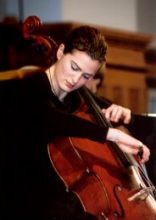
Viktor Vidovic (1973) and Ana Vidovic (1980), brilliant guitarists (brother and sister); Ana has won the 1998 International Guitarist Competition "Francisco Tarrega" in Benicasim, Spain, among forty competitors up to the age 32, see Toutes les qualités d'une jeune virtuose at Societé luxembourgeoise de guitare classique. She also won first prizes at "Albert Augustinum International Competition" in Bath, England, at the "Ferdinando Sor Competition" in Rome. She had concerts in London, Paris, Vienna, Salzburg, Rome, Budapest, Warsaw, Tel Aviv, Copenhagen, Tronto, San Francisco, Houston, Austin, Dallas, St Luis.
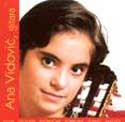
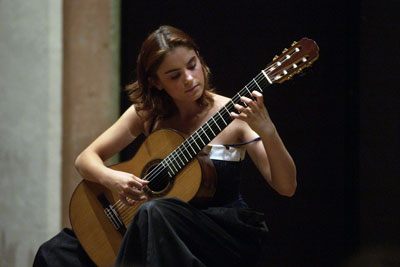
Maksim Mrvica, a young pianist born in 1975 in Sibenik, who has won the Nicolai Rubinstein International Competition of Pianists in Paris in 1999, and the International Pianist Competition Pontoise in Paris in 2001 (his second name - Mrvica - means "crumb" in Croatian language!).

An important cultural manifestation held in Zagreb is the Music Biennale, devoted to contemporary, experimental and avant-garde music. It has already a long tradition: in 1995 we had the 18th Biennale. Let us mention only Milko Kelemen, professor of composition in Stuttgart, who founded the Biennale; his Requiem for Vukovar, Osijek, Dubrovnik, Sarajevo,... has been performed in the music hall of the G. Pompidou Centre in Paris in March 1995 by the 2e 2m Orchestra (conducted by Paul Mefano).
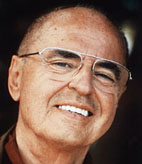
![]()
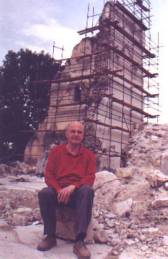
Croatian cultural society Napredak (Progress) from Sarajevo, capital of Bosnia - Herzegovina, has a nice mixed choir called Trebevic. During the 1992-95 ferocious bombing of the city of Sarajevo, they gave numerous concert in the ruined city (in conditions that are difficult to describe), as well as 30 concerts in France, including Notre Dame in Paris. Napredak also organized very successful postwar international concerts in Sarajevo, starting from 1998.
|
VOIX DALMATE, Kate - Rencontre magique, Franck Alfirevic (Indian Ocean, island of Réunion) and his sister Kate (Croatia, Kastel Sucurac). See also beautiful web pages prepared by Franck Alfirevic in French, English and Croatian, the page is downloaded locally here |
| En
écoutant les klape
dalmates, j'ai réalisé que le peuple croate avait
une
âme qui méritait d'etre
dévoilée au monde
entier...
Paolo Coelho |
Nikola Zrinski Junior (1620-1664), a Croatian statesman and writer, described in his epic ``The siege of Siget'' the heroic death of his grandfather Nikola Subic Zrinski in 1566, which entered all the historical annals of the 16th century. With his 2500 brave soldiers, mostly Croats, he was defending the fortress of Sziget in southern Hungary against 90,000 Turks.
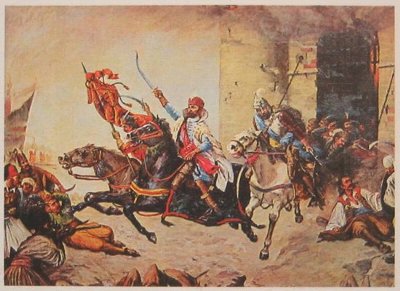
The Turkish troops were under the sultan Sulejman the Great and supplied by 300 cannons. It took them a month to defeat the Croatian soldiers, who all died a terrible death in the final battle. Despite his promise, the King Maximillian Habsburg did not help Nikola Subic Zrinski. Historians say that the Turks had almost 30,000 dead.
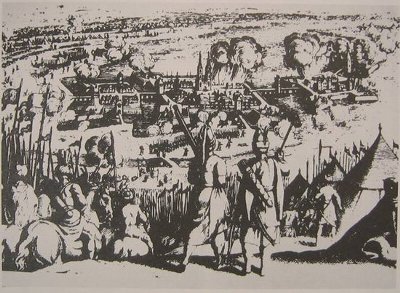
Cardinal Richelieu, the famous French minister at the court of King Lui XIII, wrote the following: A miracle was necessary for the Habsburg Empire to survive. And the miracle happened in Sziget. The above mentioned epic was written in the Hungarian language. Though written by the Croat, it is regarded to be one of the greatest achievements of the early Hungarian literature. See also here (in Croatian).
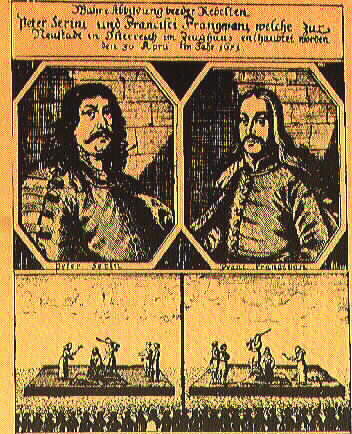 Ban
(Viceroy) Petar Zrinski
(1621-1671) and Fran Krsto
Frankapan
(1643-1671), both outstanding as statesmen and writers, are among the
most beloved figures in the history of Croatia. They had a great
successes in liberating the areas occupied by the Turks. However, the
Viennese Military council, instead of supporting them to free the rest
of the Hungarian and Croatian lands, signed a shameful peace treaty
with Turkey, by which the liberated territories had to be handed back
to the Turks. The result of the rebellion against Vienna was a cruel
public decapitation of Zrinski and Frankapan in Wiener Neustadt near
Vienna in 1671. The remains of these two Croatian martyrs were buried
in the Cathedral of Zagreb in 1919.
Ban
(Viceroy) Petar Zrinski
(1621-1671) and Fran Krsto
Frankapan
(1643-1671), both outstanding as statesmen and writers, are among the
most beloved figures in the history of Croatia. They had a great
successes in liberating the areas occupied by the Turks. However, the
Viennese Military council, instead of supporting them to free the rest
of the Hungarian and Croatian lands, signed a shameful peace treaty
with Turkey, by which the liberated territories had to be handed back
to the Turks. The result of the rebellion against Vienna was a cruel
public decapitation of Zrinski and Frankapan in Wiener Neustadt near
Vienna in 1671. The remains of these two Croatian martyrs were buried
in the Cathedral of Zagreb in 1919.
It is interesting that, while in prison from 18th April 1670 to 30th April 1671, Fran Krsto Frankapan translated Molier's "George Dandin" into Croatian, written in Paris in 1669, ie. only two years earlier. This was was its first European translation. Frankopan is the author of very famous Croatian verses Navik on zivi ki zgine posteno (Forever he lives who dies honorably).
Petar Zrinski was also very educated, being a statesman, poet, composer, polyglot. He presented his legendary sword to the town of Perast in Boka kotorska during his sojourn there in 1654.
The letter sent by Petar Zrinski to his wife Katarina (in Croatian) just a day before his death is one of the most deeply moving texts ever written in the Croatian language. It was very soon translated and published in
- Croatian (Moje drago serce), Vienna, 1671,
- English (My dear soul), London, 1672,
- German (Mein liebes Herz), Vienna, 1671,
- French (Ma chere Femme), Paris, 1691,
- Italian:
- Mio Cuore, Vienna, 1671,
- Carisima Consorte, Dresden, 1672,
- Latin (Delicium meum), Vienna, 1671,
- Spanish (Querida Esposa mia), Madrid, 1687,
- Dutch (Myn Liefste Hert), Amsterdam, 1671,
- Hungarian (Anna Catharina), Budapest, 1671.
Letter by
Petar Zrinski to his wife Katarina
Written in Croatian language in 1671
French translation (Ma chere Femme), Paris 1691
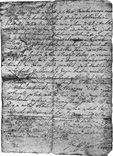 Je
te prie, ma chere Femme, de ne te
point affliger en recevant mon dernier adieau. Demain au matin sur les
dix heures, pus qu'il plait ainsi à Dieu, nous devons ton
Frere
et moy avoir la teste coupée. Nous avons pris aujourd'huy
congé l'un de l'autre avec de grands témoignages
d'amitié. Tu veux bien me permettre que je le prenne aussi
de ma
chere Femme par cette Lettre, et que je luy demande mille pardons des
chagrins que je luy ay cause, et qui n'ont esté que trop
frequens. Graces à Dieu, je fuis entierement
resigné
à la mort, et je n'en crains point l'approche. J'espere de
sa
divine bonté, que m'ayant donné la vie naturelle,
il me
fera encore joüir de la vie éternelle. Je le
prieray, dan
l'esperance d'estre demain dans le Ciel, de nous faire la grace que
nous y soyons un jour réünis, pour y estre les
témoins de sa gloire. Je ne sçay que te mander
touchant
mon Fils, et sur la perte de nos biens. J'ay tout remis à la
volonté de Dieu. Je te conjure de soufrir ce revers avec la
patience. A Neustad le 29. Avril penultiéme jour de ma vie,
à sept heures du soir. Dieu veuille répandre ses
graces
et ses benedictions sur toy et sur Aurore Veronique ma Fille.
Je
te prie, ma chere Femme, de ne te
point affliger en recevant mon dernier adieau. Demain au matin sur les
dix heures, pus qu'il plait ainsi à Dieu, nous devons ton
Frere
et moy avoir la teste coupée. Nous avons pris aujourd'huy
congé l'un de l'autre avec de grands témoignages
d'amitié. Tu veux bien me permettre que je le prenne aussi
de ma
chere Femme par cette Lettre, et que je luy demande mille pardons des
chagrins que je luy ay cause, et qui n'ont esté que trop
frequens. Graces à Dieu, je fuis entierement
resigné
à la mort, et je n'en crains point l'approche. J'espere de
sa
divine bonté, que m'ayant donné la vie naturelle,
il me
fera encore joüir de la vie éternelle. Je le
prieray, dan
l'esperance d'estre demain dans le Ciel, de nous faire la grace que
nous y soyons un jour réünis, pour y estre les
témoins de sa gloire. Je ne sçay que te mander
touchant
mon Fils, et sur la perte de nos biens. J'ay tout remis à la
volonté de Dieu. Je te conjure de soufrir ce revers avec la
patience. A Neustad le 29. Avril penultiéme jour de ma vie,
à sept heures du soir. Dieu veuille répandre ses
graces
et ses benedictions sur toy et sur Aurore Veronique ma Fille.
Pierre, Compte de Serin
 Franjo
Mihalic (1921) started his
active sporting career in the period of
the Independent State of Croatia (1941-1945), and after 1945 had to
move to Belgrade, together with many other best Croatian sportsmen. He
won a silver medal in Marathon at the Olympic Games in Melbourne
(1956); he was the winner of the International races in Sao Paulo
(1952, 1954), as well as Marathon races in Tokyo, Moscow, Boston,
Athens, Cross de
Nations in Paris (1950-1961).
Franjo
Mihalic (1921) started his
active sporting career in the period of
the Independent State of Croatia (1941-1945), and after 1945 had to
move to Belgrade, together with many other best Croatian sportsmen. He
won a silver medal in Marathon at the Olympic Games in Melbourne
(1956); he was the winner of the International races in Sao Paulo
(1952, 1954), as well as Marathon races in Tokyo, Moscow, Boston,
Athens, Cross de
Nations in Paris (1950-1961).
There is nothing extraordinary that the handball team of Cannes, France, once won a match scoring altogether 24 goals. But the following is without precedent: all the goals were scored by one single person! And that person was Ante Kostelic - Gips (nicknamed Gips = plaster; guess why!), better known as father of Weltklasse skiers Janica and Ivica. During ex-Yugoslavia, although he was one of the best handball players at that time, it had not been allowed to him to enter the representation, and that is why he turned to an individual sport of skiing as a trainer. Mr. Kostelic is not only a great expert in sports, but also a person knowledgeable on the classical literature.
No doubt, the greatest success achieved by Croatian football is the third place at 1998 World Championship (Coup du Monde) held in France. The excellent team of Holland was defeated by 2:1 in the match in Paris. Thus Croatian team became the greatest surprise of the Championship. Our national team has been led by Miroslav Ciro Blazevic (Bosnian Croat born in the town of Travnik).

Zoran Primorac won several important international table tennis tournaments: in France in 1997, in Qatar in 1998 and other. The tournaments gathered the best table tennis players of the world.
And Tamara Boros was the best ping-pong player in the world among women of non-Chinese origin for 1998 and 1999 (ranked 13th, the first 12 places being occupied by Chinese players, as well as many places after Tamara). She is famous for her attractive offensive style.
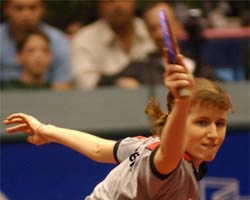
She was the winner of the 2002 TOP 12 European ping-pong competition in Rotterdam. After this success she was placed second (!) on the world rank. She won the third place at the World Championship in Paris in 2003, which is the greatest success of Croatian (and European!) table tennis for women.
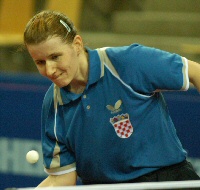
![]()
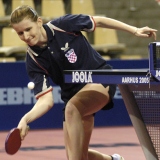
She also won the 2006 Europe TOP 12 competition in Copenhagen.
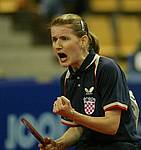
Tamara is the only one in Europe capable to cope with ping-pong players from Asia (China, Japan, etc.). In 2006 she has been invited to China to play table tennis in their professional league, which is the strongest one in the world. In 1991, as a young girl Tamara had to escape with her parents from what is now Serbia and Montenegro, when Greater-Serbian aggression on Croatia started. Her both parents are Hungarians. Together with Janica Kostelic, Tamara Boros is one of the greatest Croatian sportswomen in history.
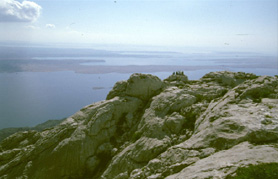 Croatia
is the
only country in the world with no mountain above 2,000 meters (though
with probably the most beautiful mountain in Europe - VELEBIT) and with
world's top skier - Janica
Kostelic. She was shining in
women's slalom
in 1999 (being only 17 years old). Her second victory of the season put
her in first place in the World Cup overall standings and strengthened
her lead in the specialty standings. In her historical victory in Serre
Chevalier, France, 5. December 1999, the difference between the first
two was 1.78 seconds, the greatest achieved in the previous 20 years!
Her ardent supporter is Goran Ivanisevic. In March 2001 Janica became
the World Cup Champion in alpine skiing. This is one of greatest
successes in the history of Croatian sport. Upon her arrival to the
Zagreb airport she obtained 1256 roses and custard slices...
Croatia
is the
only country in the world with no mountain above 2,000 meters (though
with probably the most beautiful mountain in Europe - VELEBIT) and with
world's top skier - Janica
Kostelic. She was shining in
women's slalom
in 1999 (being only 17 years old). Her second victory of the season put
her in first place in the World Cup overall standings and strengthened
her lead in the specialty standings. In her historical victory in Serre
Chevalier, France, 5. December 1999, the difference between the first
two was 1.78 seconds, the greatest achieved in the previous 20 years!
Her ardent supporter is Goran Ivanisevic. In March 2001 Janica became
the World Cup Champion in alpine skiing. This is one of greatest
successes in the history of Croatian sport. Upon her arrival to the
Zagreb airport she obtained 1256 roses and custard slices...

In 2002, at the Winter Olympic Games held in Salt Lake City in the USA, Janica Kostelic became the first Alpine skier to win as many as four Olympic medals at a single Game: three gold medals and one silver. This was a result of many years of painstaking work undertaken already at her tender age by her father Mr. Ante Kostelic and the whole family. As stated by Mr. Kostelic, this success would not have been possible without free Croatia.
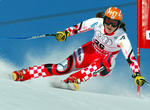
And Janica's brother, Ivica Kostelic, stunned everybody with his win in the 2001 World Cup slalom in Aspen, Colorado, USA, at the age of 22. He skied out of the 64th position in the first run, then was fastest in the second run to win in 1 minute, 38.81 seconds. It was the latest starting position for a slalom winner in World Cup history and third latest in any event. Ivica is also known as the best blues and rock guitarist among skiers, and at the same time the best skier among blues and rock guitarists.
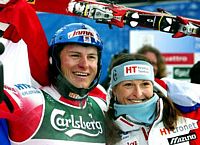
1. Ivica Kostelic, Croatia, 1 minute, 38.81 seconds. 2. Giorgio Rocca, Italy, 1:38.93. 3. Mario Matt, Austria, 1:39.00. 4. Kjetil Andre Aamodt, Norway, 1:39.43. 5. Jure Kosir, Slovania, 1:40.00. 6. Lasse Kjus, Norway, 1:40.03. 7. Michael Von Gruenigen, Switzerland, 1:40.09. 8. Kalle Palander, Finland, 1:40.15. 9. Jean-Pierre Vidal, France, 1:40.17. 10. Alan Perathoner, Italy, 1:40.18.
In 2003 Ivica and Janica Kostelic both won the title of world champions in slalom. They became the first siblings to win gold medals in the same event at the world's.
In 2006 Janica won gold medal in combined event at the Olympic games in Torino, Italy, and silver medal in Super-G. With this achievement (four gold medals and two silver) she became the most successful skier among women in the history of Olympic Games. Her brother Ivica won silver olympic medal in men's Alpine skiing combined event.
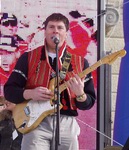
The life of the family of Kostelic is unique in the history of skiing sport (and may be in the history of sport in general). When Janica and Ivica were very young, they used to travel with their old Lada (Russian car), and also to sleep and eat in the car. At the same time other children stayed in a hotel, sleeping in their warm beds. Kostelic's were sleeping also in a small mountain tent, sometimes at the temperature reaching -20 degrees Celsius. They were not able to pay for their trainings, so they used to wake up at 4 o'clock in the morning, to wash their faces with snow, and train at dawn (free of charge) with their worn up gloves, while others were still sleeping or having breakfast.
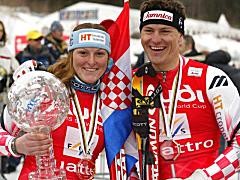
Ivica and Janica at the Olympic games in Salt Lake City,
USA, 2002, photo by Getty ImagesIt is well known that skiing is the sport of the rich. When Kostelic's went back home from Austria, Germany, France or Switzerland, several times it happened to them that they had to sell their skies in order to be able to buy petrol for their Lada... And let us not forget, at that time the Greater Serbian aggression was raging throughout Croatia and Bosnia-Herzegovina (1990-1995). Mr. Ante Kostelic-Gips himself, father of Ivica and Janica, is an amazing Croatian sportsman and trainer, former handball player, working with his children on the long run. He remembers with deep gratitude an Austrian, Mr Willie Arnsteiner, wire-keeper, who donated them 100 Schillings daily during a critical period, and who predicted their great skiing future.
At the age of 15 Janica had 22 consecutive wins at European competitions for children during one season. One day after the death of president Franjo Tudjman, Janica was skiing with mourning black armband. Young Kostelic's were raised in deep patriotism, and their sacrifices will always be remembered. Let us also mention a regular short ritual of Christian crossing immediately before every competition. It is amusing to see how "objective" European TV media strive to avoid this indicative and important detail.
Janica with her three olympic gold medals
Salt Lake City, USA, 2002At the very end of 1999 Janica had a tragic fall: four of her ligaments on the knee out of five were broken. After a very difficult operation and reconstruction of her knee, she had a painstaking program of getting back to normal living. She was able not only to walk again, but also to win on European, World, and Olympic competitions in skiing.
The human story of Kostelic's is waiting to be written in all details, with a special emphasis on low blows of "independent" media. This story is much greater than the story about their sport successes. Ivica and Janica, like many others on this web page, would never have appeared without the advent of free Croatia.
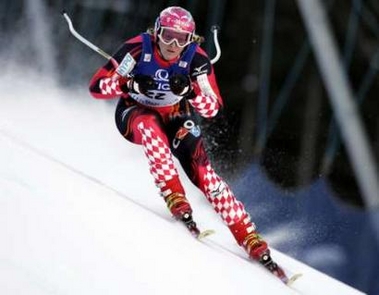
Janica Kostelic,
winning the 2006 Women Alpine Ski World Cup super-G race
in Bad Kleinkircheheim (photo by Ruters/Calle Teornstroem)
Académie des sports, Paris - Le palmarès 2005 ... Prix Monique Berlioux (performance la plus remarquable de l'année écoulée): Janica Kostelic (Croatie - Ski alpin), triple championne du monde de ski alpin.
Janica
with Croatian
coat
of arms (AP Photo/A. Trovati),
Sweden, 2006
World Cup champion for the third time,
set a new single-season points record for women after winning the final
Alpine skiing race of the season in the giant slalom.
 The
Croatian alpinist Stipe
Bozic
(Split) climbed Mount Everest twice, the first time in 1979. See his
beautiful photos at Fotoklub Split.
The Croatian Alpine Association
has a long tradition. It was founded in 1874, the same year as in
France. Let us mention by the way that the oldest novel in the world
about mountains is Planine
(Mountains), written in Croatian by Petar
Zoranic in 1536 and printed in
Venice in 1569. It is also the
oldest Croatian novel. Petar
Zoranic was born in Zadar
in 1508.
The
Croatian alpinist Stipe
Bozic
(Split) climbed Mount Everest twice, the first time in 1979. See his
beautiful photos at Fotoklub Split.
The Croatian Alpine Association
has a long tradition. It was founded in 1874, the same year as in
France. Let us mention by the way that the oldest novel in the world
about mountains is Planine
(Mountains), written in Croatian by Petar
Zoranic in 1536 and printed in
Venice in 1569. It is also the
oldest Croatian novel. Petar
Zoranic was born in Zadar
in 1508.

Iva Majoli (winner of Roland Garros at the age of 18, Paris, 1997, at that time 4th on the world list) was one of best Croatian tennis players, among the top ten in the world in 1990's.

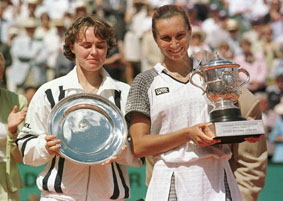
Marin Cilic won the 2005 Roland Garros gold medal in Paris in the junior category (at the age of 16, as one of the youngest competitors). He lost only one set in the whole tournament. Marin was born in the famous Medjugorje in Bosnia and Herzegovina.
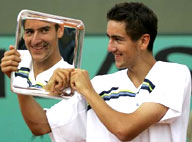
Charles Billich is outstanding Croatian painter born in Lovran in Istria, and since 1956 working in Australia. He is Honorary Citizen of Atlanta, Centennial Olympic City, USA, since 1996. Billich was the official artist of the Australian Formula 1 Grand Prix Melbourne in 1996. In 1997 he was designated the official artist of the Australian and French Olympic teams for Olympic Games in Sydney in 2000.
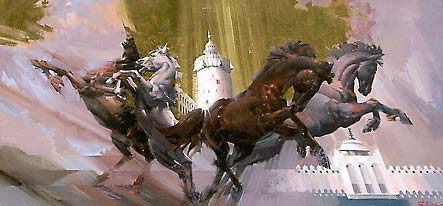
Charles
Billich
Bing Mah Yong Show
at
American Sports
Art Museum
source
FIRST CROATIANS IN THE AMERICAS
Adam S. Eterovich
on
this web since 2006, with kind permission of
the author
...
Dalmatia in the New World-New England 1523
Giovanni Verrazano
traveled to the New World in 1523-24 in the
name of the King of France and is credited with the discovery of parts
of Canada and the New England coast down to New York and the Carolinas.
New England was first called New Dalmatia.
Dalmatia in the New World: In a book by Jacques Habert on the voyages
of Verrazano in French, a chapter heading Is entitled: "La Dalmate Da
Nouveau Monde," A book by Carlos Pazzini in Italian on the adventures
of Verrazano we have "La Dalmazia del Nuovo
Mondo.� The
American Scenic and Historical Society in a description of the American
coast also has a heading; "Dalmatia of the New World." This is New
England today.
" The Verrazano letter, found in French archives, was widely quoted and
discussed by historians and cartographers, Ganong, one of the most
respected,
quotes the letter as follows: "Departing from this place, skirting
between
east and north a coast where no intercourse was had with the natives,
the land
was found very beautiful, open and bare of forests, with high mountains
back
inland, growing smaller toward the shore of the sea. In fifty leagues
we discovered
XXXII islands, all near the continent, small and of pleasing
appearance, high,
following the curving of the land, among which were formed most
beautiful ports
and channels, as in the Adriatic Gulf, in the Illyrias, and Dalmatia"
(Croatia).
(De Costa 1880)
JELACIC - written by Michel Iellatchitch, France
Introduction
Depuis longtemps, des membres de la famille Jelacic ont oeuvré à la sauvegarde de la mémoire de la famille, notamment par la conservation d'archives et la consignation de souvenirs - anecdotiques ou grands événements - par écrit.
Je leur dédis ce document qui a pour prétention de présenter une petite partie de l'histoire de la famille. Ce travail est loin d'être achevé, et j'espère pouvoir le développer progressivement.
Origines
Selon l'historien R. Lopasic, les Jelacic sont originaires de la région de Bihac. Lors de l'invasion turque, ils quittèrent cette région pour Letovanic, Biševic, Posavje et Turovo Polje [aujourd'hui Turopolje, au sud de Zagreb] au 17ème siècle, où ils changèrent leur nom en Buzinski, en référence à leur propriété de Buzin à Turovo Polje (R. Lopasic, "Bihac i bihacka krajina", 1890).
Les recherches généalogiques ont permis de remonter jusqu'à Antonius Jelacic, qui vivait dans la seconde moitié du 15ème siècle.
Auparavant, on trouve des traces en Herzegovine, où un Stanoje Jellacsics fut nommé capitaine à Klis le 2 février 1388. Le 2 mai 1390 à Sutjeska, le roi Tvrtko partagea le territoire de Split. Les bénéficiaires furent Triphon Aulae Prothorestarius, Michel de Ragusio electus Tinniensis (également évêque de Knin), Comes Stanoje Jelašic et Vladoje Logogetha. Cependant, aucun lien n’a pu être établi entre ce Jellacsics et le reste de la famille.
Paulus Jelacic, fils d’Antonius, reçut en 1515 du roi Vladislaus II Jaguellon des terres situées sur la rive droite de la rivière Kupa, près de Lasinje. Cet endroit était connu sous le nom de “ Jelacicevo selo ”. Les Jelacic le quittèrent après 1568.
En 1627, un récit de duel entre seigneurs croates et turcs mentionne un Vuk Jelacic, capitaine à Letovanic (Ratkay : Memoriae regnum et banorim - Vitezovic, kronika hrvatska). Ce village est situé sur la rive gauche de la rivière Kupa.
Le nom complet, du moins pour une partie de la famille, est Jelacic de Buzim (Jelacic od Buzima). Cette dénomination apparait dans les écrits pour Franz (1746 - 1810) et son fils Josip (1801 - 1859, ban de Croatie). Il s'agirait du village de Buzim situé dans la région de Lika, à une dizaine de kilomètre de Gospic.
Au cours de l'histoire, des Jelacic ont quitté la Croatie : pour la Hongrie en 1609, pour la Russie en 1740. Après le premier conflit mondial, l'émigration a été accentuée. Des Jelacic sont partis dans les différents pays d'Europe, en Amérique du Nord et du Sud, en Chine, en Australie, créant ainsi de nouvelles branches. L'orthographe du nom a aussi évolué, en s'adaptant aux langues de ces pays : la version croate - Jelacic -, a été déclinée en Ielachijch, Jelachich, Jellachich, Jellatchitch ou Iellatchitch, sans oublier la version cyrilique.
La branche russe
En 1740, Saint Pétersbourg est un vaste chantier. La ville a été fondée trente sept ans plus tôt dans l'embouchure de la Néva par le Tsar Pierre 1er dit "Pierre le Grand" et est devenue la nouvelle capitale de l'empire russe. Le Tsar souhaitait ainsi ouvrir largement la Russie à l'Occident. Cependant, depuis la mort de son fondateur en 1725, "le pays semble complètement absorbé par les luttes continuelles pour le pouvoir entre des prétendants incapables, par l'ascension et la chute, indéfiniment répétées, de non moins déplorables favoris, par des intrigues de cours de toute espèce, la terreur policière de Biron" (Michael T. Florinsky, 1894-?, économiste et historien américain d'origine russe). De 1730 à 1740, l'impératrice Anne, nièce de Pierre le Grand, occupe le trône de Russie. Son règne est présenté traditionnellement comme une période dominée par des favoris allemands, qualifiés de "parti allemand". Fin 1741, Elizabeth, fille du Tsar Pierre le Grand, poussée les partisans d'un pouvoir dans des mains russes, renversa le jeune Tsar Ivan VI (un bébé de quelques mois, un arrière petit neveu de Pierre le Grand) qui succéda à Anne et devint ainsi la Tsarine Elizabeth.
C'est dans ce climat que, vers 1740, Franz-Luka Jelacic arrive à Saint Pétersbourg. Il semble qu'il ait voulu échapper à une carrière ecclésiastique, et il a ainsi tenté sa chance dans cette Russie qui s'ouvrait à l'Occident.
Franz-Luka, son fils et ses petits enfants restèrent catholiques et résidèrent dans la partie occidentale de la Russie, à Saint Pétersbourg ou dans les pays baltes annexés. C'est son dernier petit-fils, Franz-Leopold, qui franchit le pas de l'intégration en épousant une Russe et en se convertissant à l'orthodoxie. Franz-Luka fit naître la branche russe, Franz-Leopold l'enracina. Tous les Jelacic russe descendent de Franz-Leopold et ils vécurent en Russie jusqu'aux révolutions de 1917.
Le leader croate Stjepan Radic connu Evgueni, un des petits fils de Franz Leopold. Il écrivit un article dans le journal "Hrvatsko Kolo" en 1909 : "Ruska grana nasih Jelacica" ("La branche russe de nos Jelacic", texte en Anglais)
Les évènements à partir de 1914 brisèrent la branche russe. Certains périrent pendant la guerre mondiale ou la guerre civile, certains restèrent et furent victimes des tribunaux révolutionnaires ou des purges staliniennes, enfin d'autres purent quitter la Russie et connurent des fortunes diverses. Les descendants de ces-derniers vivent aujourd'hui principalement en France, Grande-Bretagne et en Australie où de nouvelles branches de la famille ont pris racine.
...source
En détails :
Vers 1740, Franz ou Franz-Luka (°1720 à Vienne / Autriche- après 1776 à Moscou / Russie) partit s’installer à St Pétersbourg, en Russie. Il y étudia la médecine et fut diplômé en 1743 à l’hôpital général de St Pétersbourg. Il participa en tant que médecin à trois expéditions en Chine (1747, 1754-1756 et 1757-1764). En 1756, il fut chirurgien à l'hôpital principal de Moscou, puis en 1764 chirurgien à l’hôpital général de St Pétersbourg.
Il eut un fils, Josef-Anton, nommé sans doute ainsi en l’honneur des deux frères de Franz-Luka.
Josef-Anton était traducteur auprès de l’administration économique de la région de Derp-Pernau (aujourd’hui Tartu en Estonie). En 1802, il fut engagé à la " Kaiserliche Universität zu Dorpart " (l'université impériale de Dorpat) en tant que lecteur et traducteur de Russe pour la correspondance officielle. Cette université venait d’être rouverte par Alexandre 1er, après avoir été fermée pendant plus d’un siècle suite à l’annexion de la région par Pierre le Grand. En 1804, il fut nommé professeur de Russe au lycée (Gymnasium) de Dorpat.
Marié à Johanna Dorothea Palen, il eut douze enfants :
1.1.1 : Maria Elisabeth
(1787-1797),
1.1.2 : Joseph Cornelius
(1788-1791),
1.1.3 : Johanna Catharina
(1790-1791),
1.1.4 : Josephine Dorothea
(1792-1847),
1.1.5 : Anna Dorothea
(°1794),
1.1.6 : Friderica Amalia
(°1796),
1.1.7 : Emilia Aurora
(1798-1887),
1.1.8 : Adolph Gustav
(°1800),
1.1.9 :
Wilhelm Eduard
(°1802), sa
descendance s'installa en
Pologne
1.1.10 : Catharina Adelheide
(1804-1805),
1.1.11 : Anton Julius
(°1806) et
1.1.12 : Franz Leopold (1808-1888)
.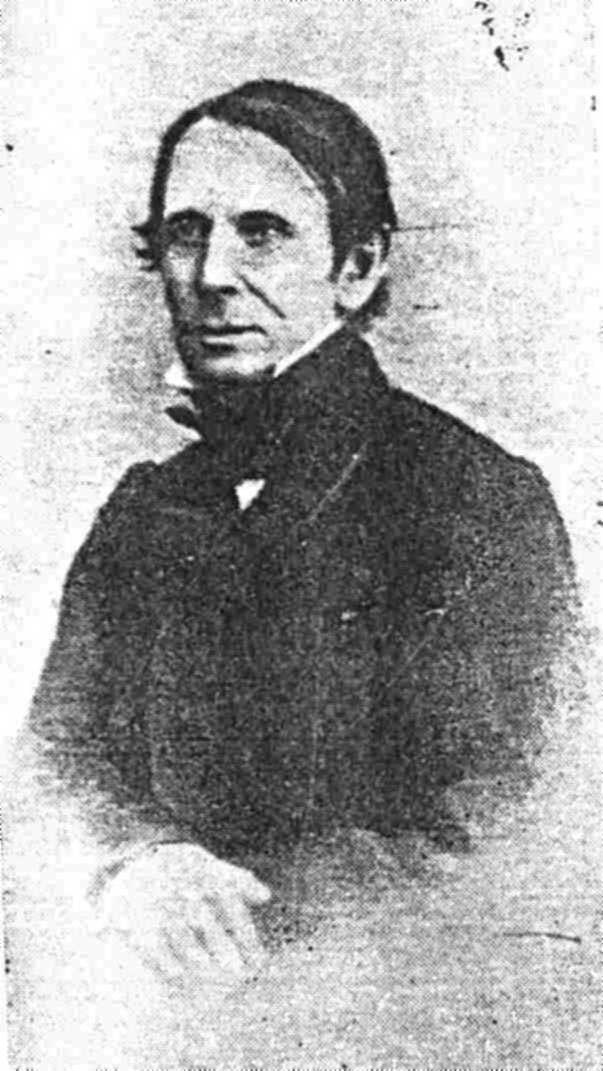
(Franz Ossipovitch Jelacic, archives
URSS)
Franz Leopold (°1808 à Dorpat-Tartu / Estonie - 1888 à Kazan / Russie) étudia à l’université de Vilno (aujourd’hui Vilnius – Lituanie) où il obtint un doctorat de médecine en 1832. En 1834 il accéda à la chaire de médecine à l’université de Kazan, où il se spécialisa dans l’ophtalmologie. Après un voyage d'étude de neuf mois à l'étranger (Berlin, Vienne, Paris, Munich) au cours duquel il acheta du matériel médical, il fonda la clinique universitaire de Kazan, ce qui lui valu les félicitations du ministre en 1845. Il fut nommé professeur émérite en 1859 et membre d'honneur de l'université en 1864.
Jusqu'alors, tous les Jelacic étaient catholiques. Afin de pouvoir épouser Maria Razumosky, russe orthodoxe, Franz-Leopold (ou Franz Ossipovitch Iellatchitch en russe) se convertit à la religion orthodoxe.
Marié à Maria K. Razumovsky (1821-1881), il eut quatre enfants :
1.1.12.1 : Nicolas (1841-1877),
Nicolas s'installa en Ukraine.
Marié
à Catherine K. Kholodowsky
(1850-1910),
(Soeur
de
Sophia (1851-1929) et Anna (1854-1939), cf 1.1.12.4 Alexandre)
il
eut un enfant :
1.1.12.1.1 : Kyril (1869 - 1895),
Marié à Ludmila K. Pomian-Pomazansky (1866 - 1944), il eut deux enfants :
1.1.12.1.1.1 : Alexis (1892 - 1941),
Il émigra après la révolution russe de 1917 en Yougoslavie,
Marié à Maria A. Karpitzky (1885 - 1966),
1.1.12.1.1.1.x : Leur descendance vit aujourd’hui en Croatie.
1.1.12.1.1.2 : Alexandre (1894 - 1911),
1.1.12.2 : Julia (1843-1913),
Julie épousa de Baron Friedrich v. Rosen. Leur descendance vit aujourd’hui en Russie, Allemagne et Autriche
1.1.12.3 : Michel (1845-1917),
Michel fut juge à Samara.
1.1.12.3.x : Sa descendance vit aujourd’hui au Brésil et en Irlande mais ne porte plus le nom de Jelacic.
1.1.12.4 : Alexandre (1847-1916).
Alexandre (1847 à Kazan / Russie -1916 à St Petersbourg / Russie) fut juriste, spécialiste de problèmes agraires. Il avait hérité de la propriété familiale "Pavlovka" dans le gouvernement de Samara.
Marié
à Sophia K. Kholodowsky
(1851-1929),
(La
sœur de
Sophia et de Catherine Kholodowsky, Anna (1854-1939) épousa
Féodor Stravinsky
(1845-1902). Ils eurent quatre enfants, dont Igor Stravinsky (1882-1971))
il
eut cinq enfants :
1.1.12.4.1 : Nicolas (1872-1938).
Nicolas (1872-1938) fit des études de droit, fut secrétaire adjoint du Conseil d’Etat à St Pétersbourg, puis conseiller juridique auprès du Métropolite Benjamen de St Pétersbourg. Condamné à mort en 1922, gracié et exilé, il sera à nouveau arrêté et fusillé en 1938.
Marié
à Nathalia I. Polonski (1870-1929),
(Nathalia Polonski
était la fille du
poète russe Iakov Polonski (1819-1898))
il
eut deux enfants :
1.1.12.4.1.1 : Nicolas (1894-1917) et
1.1.12.4.1.2 : Georges (1897-1976).
Georges (1897 à St Petersbourg / Russie -1976 à Paris / France) fit parti du corps des Pages (promotion du 01/02/1917) et intégra le régiment Préobrajenski. Après la révolution bolchevique, il rejoignit les armées blanches des généraux Korniloff et Denikine. Après la guerre civile, il émigra en France. La transcription du nom Jelacic (écrit en cyrillique russe) en Français donna "Iellatchitch". L'auteur de ces lignes est un de ses petit-enfants.
Marié
à Irène S. Wilczkowski (1902
- 1989)
(Irène
Wilczkowski (1902 à St Petersbourg / Russie - 1989
à
Paris / France), fille de
Serge Wilczkowski (1871-1934, général de brigade,
colonel
à la suite du
Régiment des gardes Préobrajensky,
délégué de Sa Majesté
l’Impératrice
de
Russie au service des blessés, commandeur de
l’ordre de St
Wladimir)).
1.1.12.4.1.2.x : Leur descendance vit aujourd'hui en France, principalement en région parisienne.
1.1.12.4.2 : Serge (1874-1940),
Serge fut rédacteur du journal "Pays de Volga" en 1914-1915 et "Jour de Volga" en 1915-1918. Il participa au gouvernement provisoire de Samara en 1918. Après la chute du gouvernement provisoire de l'amiral Koltchak, il émigra en Chine. Il est mort à Pékin (Chine) en 1940 sans descendance.
1.1.12.4.3 : Michel (1877-1922),
Michel fut un auteur de pièces de théatre dramatique.
1.1.12.4.3.x : Sa descendance vit aujourd'hui en Australie, en Grande-Bretagne, en Russie et au Brésil.
1.1.12.4.4 : Evgueni (1882-1944),
Evgueni étudia à l'université de St Petersbourg et se spécialisa dans les problèmes d'éducation et de lutte contre l'illettrisme. Il enseigna dans la région de St Petersbourg en 1903-1906. Il vécut à Samara en 1909-1910. Après la révolution russe, il émigra en Yougoslavie ou il fut assassiné en 1944.
Marié à Véra v. Richter,
1.1.12.4.4.x : Leur descendance vit aujourd'hui en Italie et en Serbie.
1.1.12.4.5 : Gabriel (1894-1941),
1.1.12.4.5.x : Sa descendance vit aujourd'hui au Brésil.
Croatian soldiers served in many European armies since the seventeenth century. So in the French army in the 17th century, during the reign of Louis XIII, there was a cavalry composed exclusively of the Croats, called Royal - Cravate, which existed in the period of 1664-1789. These soldiers gave the world something that is today unavoidable in fashion: the tie, called la cravate by the French and by the Germans die Krawatte - the expression was coined from the Croatian name, and mentioned for the first time in 1651. The name entered also
- the Italian language - Cravatta
- Spanish - Corbata
- Portugese - Gravata
- Croatian - Kravata
- Irish - Carabhat
- English - Cravat
- Swedish - Kravatt
- Finnish - Kravatti
- Flemish - Krawaat
- Polish - Krawat
- Ukrainian - Kravatka
- Romanian - Cravata
and many other. So when you wear a tie, remember its Croatian origin.
Many variants of the Croatian name can be found in old documents (for more information see eg. [Klaic, Hrvati i Hrvatska]):
Crovat, Cravat (-> cravate), Crobat, Corbat, Krabat,
Charwath, Crawat, Krawat, Churbate, Grawat,
Charwaten, Corbetha, Curewate, Corwate,
Chrowat,Crowat, etc.
In Italy one can encounter the second names of Cravati, Cravatti, Cravetto, Cravedi, Craviotto, Croattimi, Croatto, obviously all of them derived from the Croatian name. You can easily check this in Italian phone books.
...
It is little known that a famous French King Louis XIV had his cravatier du roi. Cravatier du roi had a very serious and important duty in the state administration: to offer the King a basket full of finest cravats every morning! See [Peroche], p. 121.
...
Two Croatian regiments of Royal Cravate were under the French flag in military operations undertaken by Napoleon I in Russia. Especially important was their insurance of Napoleon's retreat from Russia across Berezino in 1812/13. More than two thirds of the Croats lost their lives: 400 soldiers and 10 officers, plus 357 dead of famine and freezing. Only 296 survived. According to Marmont, Napoleon declared: ``I never had more courageous and better soldiers''. According to [Dolbeau], p 18, Napoleon addressed the following message to these 296 Croatian survivors:
Hier, j'ai pu m'assurer de mes propres yeux de votre courage et de votre fidélité. Vous avez acquis la gloire immortelle et l'estime, et je vous place parmi mes meilleurs troupes. Pour votre courage, je vous promets de vous accorder tout ce que vous me demanderez de bon droit lorsque nous serons de retour. Je suis satisfait de vous, très satisfait.
Demobilized in 1814, only several officers stayed in France, like the "fameux général" Marko Sljivaric, comte de Heldenburg (1762-1838), who became commander of the city of Antibes.
In the French Military Museum in Paris (Maison des Invalides) there is a memorial tablet containing the following words (``To the memory of Croatian regiments that under the French flag have shared the glory of the French Army''):

|
|
The historical tragedy of the Croats was that they had to fight against each other in opposing armies, like in French and Austrian army, Turkish, Venetian.
LIBERTÉ
DE LA PRESSE
Freedom of the press / Libertad de la Prensa
Un journaliste arreté chez lui a la demande du Tribunal pénal international
� Nous déplorons cette arrestation soudaine de Josip Jovic par la justice croate, a la suite d’un mandat d’arret du TPIY, qui paraît disproportionnée par rapport a ce qui lui est reproché et qui constitue un dangereux précédent. Compte tenu du mandat du tribunal de La Haye, dont la mission consiste a juger les crimes internationaux les plus graves, il est surprenant qu’une de ses décisions débouche sur l’arrestation d’un journaliste qui, s’il est vrai qu’il n’a pas respecté la loi, n’a pas pour autant commis de crime de sang. Il en est de meme pour les quatre autres journalistes croates également accusés d’outrage a la cour. Considérant que le journaliste ne représente pas un danger pour la Croatie et le TPIY, Reporters sans frontieres demande la libération sous caution de Josip Jovic �, a déclaré Reporters sans frontieres.
Josip Jovic, rédacteur en chef du quotidien Slobodna Dalmacija, a été arreté le 6 octobre 2005, vers 17h, alors qu’il donnait une interview a son domicile de Split.
... LIBERTÉ DE LA PRESSE ...
One of the most outstanding and most popular personalities in the Croatian political history was Stjepan Radic (1871-1928), the leader of the Croatian Peasant Party, assassinated in the Yugoslav parliament in Belgrade (capital of present Serbia) in 1928 together with his colleagues. The assassination was organized at the Royal court in Belgrade. Radic strived to renew the Croatian sovereignty and the economic and cultural emancipation of Croatia. He wanted the state of the Southern Slavs to be reorganized on confederative basis, without Serbian hegemony.
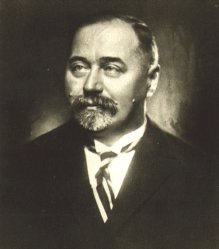
For more information see:
- Stjepan Radic, His Life - His party - His politics, written by Ante Cuvalo,
- The significance of Stjepan Radic to the Croatian nation in the past and present (1825-1871), by Jure Petricevic
- Stjepan Radic: The Russian branch of our Jelacic's
Stjepan Radic completed his studies in France, on École Libre des Sciences Politiques in Paris, with the thesis La Croatie actuelle et les Slaves du sud.
- During the 1991-1998 Serbian occupation of the city of Vukovar, one of its streets was renamed after Radic's assassin. International community insists on Croatia that the name of assassin of one of greatest Croats of the 20th century is left for the time being. It seems that the Croats will endure this insult, in the name of peaceful reintegration of the Vukovar region which had started in the beginning of 1998 under the auspices of UN.
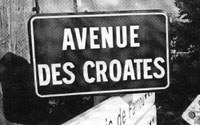 Here
we would like to mention a tragic fate of a division composed of
about 500-1000 Catholic and Muslim Croats
which has been sent by force to France in 1943 by the Nazis in order to
fight there. Originally this division was predicted to act as a
defensive formation exclusively on the Croatian soil. A rebellion of
the Croatian troops which took place in Villefranche-de-Rouergue
(capital of an arrondissement in the region of Aveyron) in September
1943 shows clearly the patriotism of Croatian soldiers. The goal of the
rebellion within Nazi troops was to approach the French Liberation
Movement and Anglo-Americans, and then to come back to Croatia. It had
a tragic outcome, with only a few who managed to escape. This
rebellion, the first within
the Nazi military system during
the
WW2, was highly esteemed by the French citizens of
Villefranche-de-Rouergue. When the city was liberated in 1944, they
decided to pay tribute to these tragic victims by naming one of its
streets as Avenue des Croates.
The French witnesses called this
insurrection la
révolte des Croates.
According to Louis
Erignac, Villefranche-de-Rouergue was the first free city of occupied
France. Even today citizens of the city regularly commemorate this
tragic event (September 14th). In 1952 the participants of the Croatian
Partisan Movement planned to build up a memorial to the Croatian
victims in Villefranche-de-Rouergue (with a sculpture of Vanja Radaus),
but this has been prevented by the (ex)Yugoslav government in Belgrade
under the pretext that in this way the "quislings" would be honoured.
For more details see [Croatie/France],
and a
monograph [Grmek,
Lambrichs] related to this
subject.
Here
we would like to mention a tragic fate of a division composed of
about 500-1000 Catholic and Muslim Croats
which has been sent by force to France in 1943 by the Nazis in order to
fight there. Originally this division was predicted to act as a
defensive formation exclusively on the Croatian soil. A rebellion of
the Croatian troops which took place in Villefranche-de-Rouergue
(capital of an arrondissement in the region of Aveyron) in September
1943 shows clearly the patriotism of Croatian soldiers. The goal of the
rebellion within Nazi troops was to approach the French Liberation
Movement and Anglo-Americans, and then to come back to Croatia. It had
a tragic outcome, with only a few who managed to escape. This
rebellion, the first within
the Nazi military system during
the
WW2, was highly esteemed by the French citizens of
Villefranche-de-Rouergue. When the city was liberated in 1944, they
decided to pay tribute to these tragic victims by naming one of its
streets as Avenue des Croates.
The French witnesses called this
insurrection la
révolte des Croates.
According to Louis
Erignac, Villefranche-de-Rouergue was the first free city of occupied
France. Even today citizens of the city regularly commemorate this
tragic event (September 14th). In 1952 the participants of the Croatian
Partisan Movement planned to build up a memorial to the Croatian
victims in Villefranche-de-Rouergue (with a sculpture of Vanja Radaus),
but this has been prevented by the (ex)Yugoslav government in Belgrade
under the pretext that in this way the "quislings" would be honoured.
For more details see [Croatie/France],
and a
monograph [Grmek,
Lambrichs] related to this
subject.
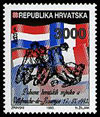 See
also Louis Erignac: La
révolte des Croates,
published in 1980 and 1988.
See
also Louis Erignac: La
révolte des Croates,
published in 1980 and 1988.
- Yves Molly, a French poet, wrote a poem Fils de Croatie (Croatian sons).
Croatia gave a great contribution to the victory of the Antifascist coalition in the Second World War. Out of all the brigades and divisions of Tito's Liberation Movement created on the territory of former Yugoslavia, the great majority was from Croatia.
We find it pertinent to cite the following words of Georges-Marie Chenu, Ministre plénipotentiaire, the first Ambassador of France in Zagreb (1992-94), see [Gregory Peroche], p. 10:
Pendant trop longtemps, l'opinion publique française ignora que, parmi les résistants au nazisme dans la région, plus de la moitié étaient croates ou slovènes et qu'au début de 1944 - les combats se prolongèrent après la capitulation du Reich - il y avait en Croatie autant de résistants actifs qu'en France, pays neuf fois plus peuplé!
FILS DE CROATIE
Yves Mouly (1945), Vilefranche-de-Rouergueu, 1984
ILS
AVAIENT DU QUITTER
EUX AUSSI LEUR PAYS.
POUR ALLER AU COMBAT
CES FILS DE CROATIE
EN ETANT ENROLES
DANS LES TROUPES NAZIS
ILS AVAIENT ENDOSSE
LA TENU VERT DE GRIS
SOLDATS
D'UNE NATION
NE VOULANT QU'UNE RACE
POUR ELLE VOUS ETIEZ
DE LA CHAIR A CANON
EN VOUS RESTAIT POURTANT
D'UNE FACON TENACE
LA FIERE VOLONTE
DE FAIRE REBELLION
APPRES
UN LONG PARCOURS
DANS L'EUROPE EN GUERRE
VOUS ETES ARRIVES
ICI DANS LA CITE
ET LA VOUS AVEZ FAIT
CE QUE VOUS DEVIEZ FAIRE
POUR VOUS DEBARASSER
DU JOUG QUI VOUS PESAIT
LA
MALHEUR A VOULU
QUE CETTE TENTATIVE
NE PUISSE RENCONTRERE
SE SUCCES ESPERE
ALORS S'EST DECENCHEE
LA FORCE REPRESSIVE
QUI VOUS A FAIT SUBIR
D'ATROCES CRUAUTES
 ENFANTS
DE CROATIE
ENFANTS
DE CROATIE
VOUS ETES MORTS EN FRANCE
C'EST LA' SUR NOTRE SOL
QUE VOUS ÊTES TOMBES
EN CHACUN D'ENTRE NOUS
VIVANT A VILLEFRANCHE
VOTRE GESTE HEROIQUE
EST A'JAMAIS GRAVE
VOUS
RESTEREZ TOUJOURS
PRESENTS DANS NOS MEMOIRES
VOUZ QUI AVEZ SOUFFERT
ET QUI AVEZ PERI
VOS MORTS SONT DEVENUES
DES FAITS DE NOTRE HISTOIRE
ET VOTRE SOUVENIR
FAIT PARTIE DE NOS VIES
Yves Mouly: ...I am not a historian, and my text "Fils de Croatie" is in fact only a "scream of heart" which came out of me because of Croatian rebellion in my city before I was even born, but about which people talked since my earliest childhood, in postwar era. These tragic events marked the history of our city, and in this way became the heritage of its citizens...
Reference: Stanko Tensek, Francuz opjevao hrvatsku pobunu, Marulic, 4, 2000, pp 680-685.
The
culmination of the Serbian police
terror took place during the personal dictatorship of king Aleksandar
Karadzordevic since 1929. One of the historical documents from that
period, showing `methods' of the Serbian police and administration, is
a bill on 13 dinars and 15 paras charged to a Croatian family in 1934
for five bullets fired at the father, who was sentenced to death. The
families were persuaded even to pay the `expenses' of the execution
within eight days, under the threat of confiscation of their property.
Croatian archbishop Alojzije
Stepinac reported
about this event to the French diplomat Ernest Pezet in 1935.
- A photocopy of the bill received by the son of Ivan Varga to pay 13.15 dinars for the five bullets by which his father was killed on January 11, 1934 (see the bottom of the page).
- [Cristophe Dolbeau], and Marija Novak: "Stepinac o srpskom teroru u Meddimurju", Glas koncila, May 17, 1998, p. 20.
Croatian scientists were also victims of the Serbian terror. So Milan Sufflay, historian of international reputation known by his numerous scientific contributions, especially in the field of albanology, was assassinated by a steel rod on a street in the center of Zagreb in 1931. After the dramatic events that followed, Albert Einstein and Heinrich Mann sent an appeal to the International League of Human Rights in Paris to protect Croats from the terror and persecutions of the Serbian police. It was also published in the New York Times (6th May 1931). As we learn from this letter, the newspapers in Zagreb were not allowed to report about Sufflay's activity; it was not allowed to attach a half-mast flag on the main building of the University of Zagreb in his honour; the time of the funeral could not be announced publicly, and even condolence messages were not allowed to be telegraphed. In their letter Einstein and Mann hold the Yugoslav king Aleksandar explicitly responsible for the state terror over the Croats. The letter concludes that it should not be tolerated that killings be allowed as a means to achieve political goals. We should not allow killers to be promoted as national heroes. The king himself was assassinated by a Macedonian patriot in Marseille in 1934 (there are indications that there was a collaboration of the Macedonian Revolutionary Organization with the Ustasha organization).
- Albert Einstein and Heinrich Mann: Appeal on the occasion of killing of Professor Milan Sufflay in Zagreb
- New York Times (May 6, 1931): Einstein Accuses Yugoslavian Rulers in Savant's Murder,
- A Letter of Protest sent by American intellectuals organized by Roger N. Baldwin, Chairman of the International Committee for Political Prisoners, to the Yugoslav representative in Washington on November 24, 1933.
An extremely valuable
account on the terrorist methods of the
Pan-Serbs in Yugoslavia between the two WWs has been written by Henri
Pozzi, a brave French diplomat
(his mother was English) and a close
witness, in his book Black
Hand over Europe, London, 1935.
"Black hand"
is the name of the Pan-Serbian secret terrorist organization, very
close to the Royal court in Belgrade. It was the "Black hand" that
organized the assassination of the Austrian archduke Ferdinand Habsburg
in Sarajevo in 1914, which meant the beginning of the First WW.
The
book contains an
important article The Story of
the Black Hand and the Great War
by a Montenegrin intellectual Voislav
M. Petrovich, p. 243-267. He
committed suicide in London in 1934
after a violent campaign instituted against him and threats of the
Black Hand. It is
interesting that Petrovich had published a Serbian grammar in London in
which he succeeded in getting the English Press to use the word
"Serbia" instead of "Servia".
All the best posts in Croatia were occupied by the Serbs. Around 1930 the situation in Croatia was to following (see Henri Pozzi, p.35):
- at the Croatian ministry of the Interior 113 out of 125 officials were Serbs,
- at the Foreign office 180 out of 219,
- at the Presidency of the council 13 out of 13,
- at the Ministry of Justice 113 out of 136,
- at the Securities Bank 196 out of 200,
- at the Court 30 out of 31.
- Croatia had to keep about sixty thousand Serb gendarmes, police and soldiers.
One of outstanding Croatian emigrants was Ante Ciliga (born in Istria, Segotica near Vodnjan, 1898 - 1992) who spent 6 years in Russian concentration camps: 1930 - 1936. His book Au pays du grand mensonge, Paris 1938 (In the land of great lie) revealed the truth about stalinist concentration camps to the world audience. It is probably the first anti-stalinist book, translated into many languages, including Japanese. He also spent one year (1942/1943) imprisoned in the Jasenovac concentration camp. Other books: The Russian Enigma, London 1940, Il labirinto jugoslavo, Rome 1983.
Vuk Draskovic, whose frequently reedited novel "The knife" represents an appeal to hatred against Muslim Slavs (see [Véronique Nahoum - Grappe, p. 66]); its French translation has been expurgated from its most provocative passages against Muslims.
Mirko Grmek: La mémoire manipulée (Le Monde, 12/04/1991), Mirko Grmek est directeur d’études a l’École pratique des hautes études
It is interesting that for the preparation of their costumes Croatian women in Backa used silk material from Lyon, France.
Source: Croatian Coat of Arms
Two
Croatian coats of arms on the Kostrena
steamer
(photo from [Barbalic,
Marendic, p. 77]):
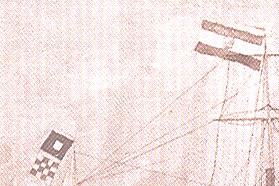
Pepe Medanic, captain of a steamer "Kostrena", saved a French steamer
Gaulois in Biskay bay in very difficult conditions. The French
president conferred a medal. Maritime press reported on this saving
throughout the world.
See the facsimile from [Barbalic, Marendic, p. 77]:
|
RÉPUBLIQUE FRANÇAISE MINISTÈRE DE LA MARINE DIRECTION DE LA NAVIGAITON ET DES PÊCHES MARITIMES Le
Ministre de la Marine certifie que, par
Décret en date du 10 mai 1912, le Président de la
République Française a
décerné la
Médaille de Sauvetage en or de 2ême classe
à
Monsieur le capitaine Medanovich commandant le vapeur hongrois (!)
"Kostrena", qui a recueilli à son bord, le 25 janvier 1912,
aprés de maneuvres rendues trés difficiles Par Directeur de la Navitation et les Pêches Maritimes [signature] Paris, le 10 Mai 1912 [signature]
|
Croatia - Australia
Croatia - Japan Croatia - South America
Croatia - its History, Culture and Science
